Post Cards of Coventry
Broadgate
All of these pictures are available on Post Cards which became popular after the law giving a monopoly to the Post Office was changed in 1895. They were the emails of their day.
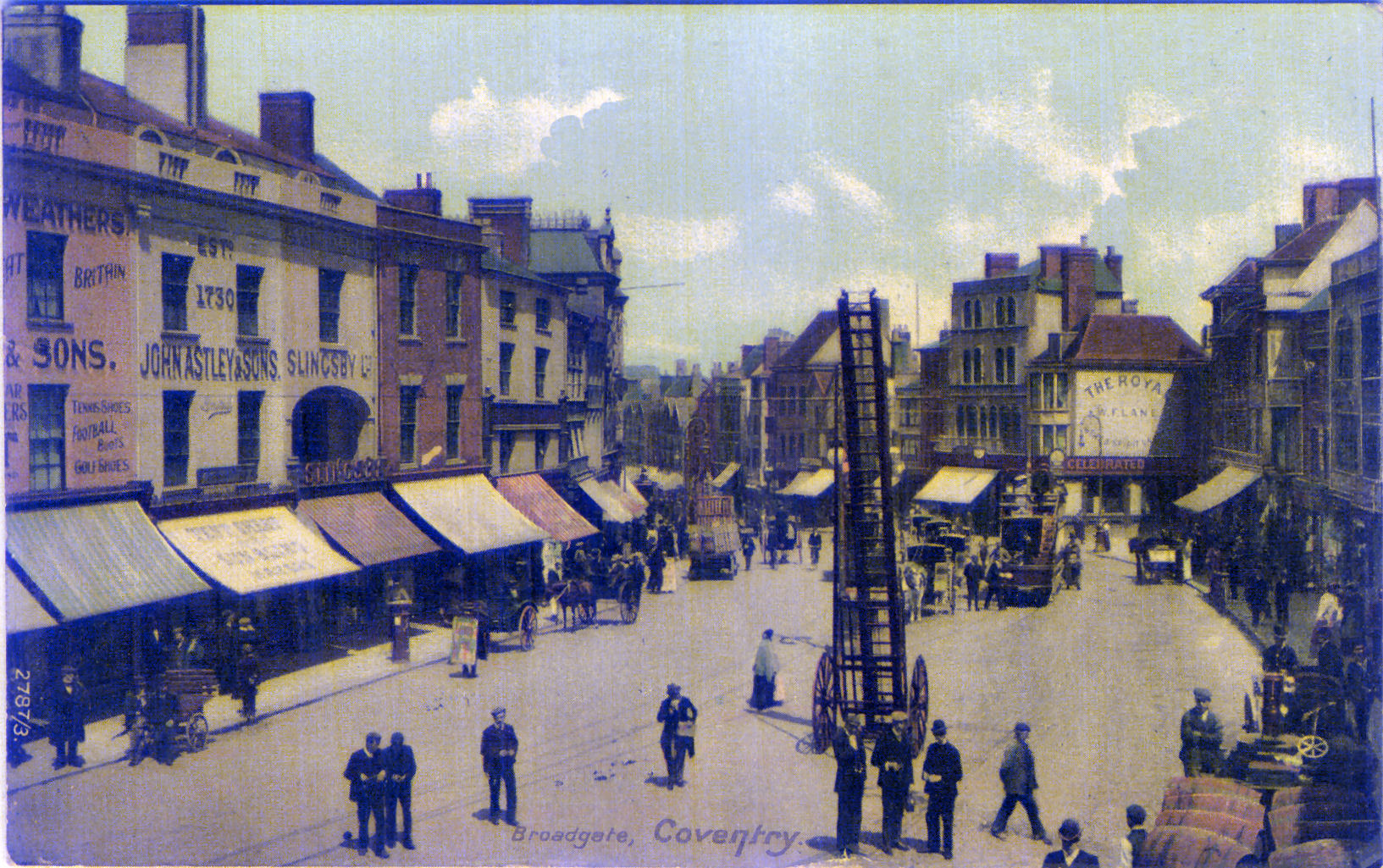
Broadgate has long been the central focus of the City of Coventry. There appear to be only horse-drawn vehicles and bicycles in this picture. The ladders in the centre were the only fire brigade until 1912 when the fire station in Hales Street was built. mote John Astleys shop which soon after this moved to the old Calcott Motor works in Gosford Street where it remained until around 2000 when it moved to the former Standard-Triumph works at Canley. The tram lines can be seen but there are no overheads wires. The photographer might have used air-brushing or perhaps the trams were still driven by steam at this date (1893). The Royal Vaults on the right was a high quality establishment at the top of Butcher Row. Just left of centre can be seen a post box which attracted an IRA bomb on 12 January 1939.
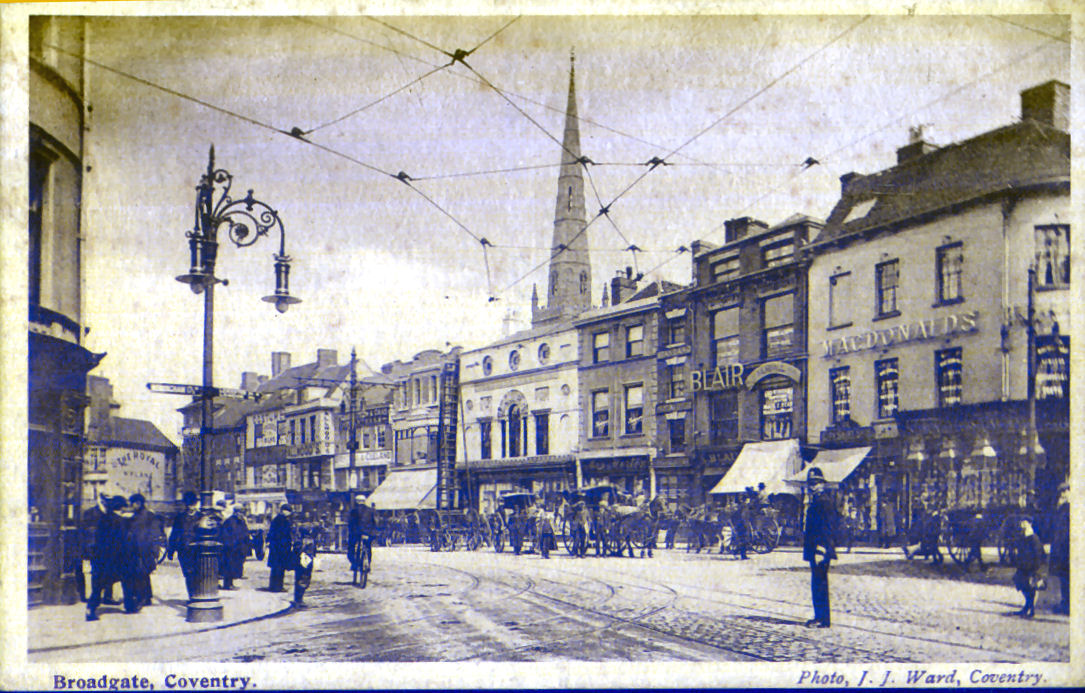
This view is probably just after 1895 when the trams were electrified. Note the tram wires and the ladders still in place. The square is cobbled and there was sufficient traffic to justify a constable on point duty. The traffic does not include any motorised vehicles. Note on the right was clearly the founding McDonalds despite the spelling difference. Note also the elegant cast iron lamp post. The spire is Holy Trinity.
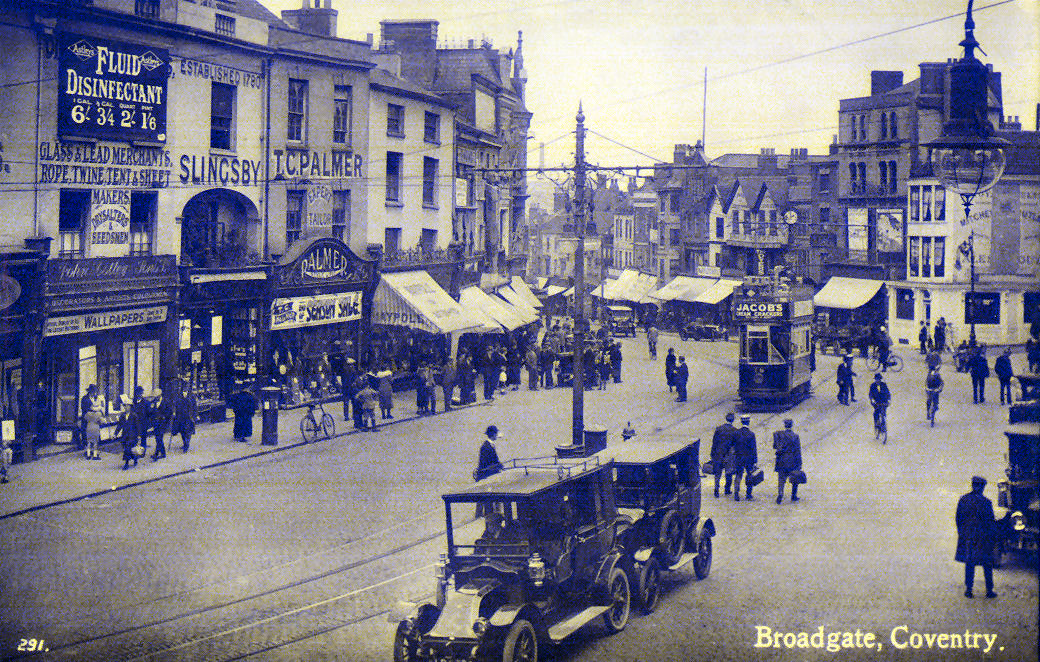
This view is probably around 1912 as the ladders have disappeared and the flashy new automobiles are in evidence. I believe these cars are Citroens. Note Astleys selling disinfectant at 6/- (six shillings, 30 pence) a gallon or 1/6d a pint. The road at an angle on the left is Cross Cheaping running down to The Burgess.
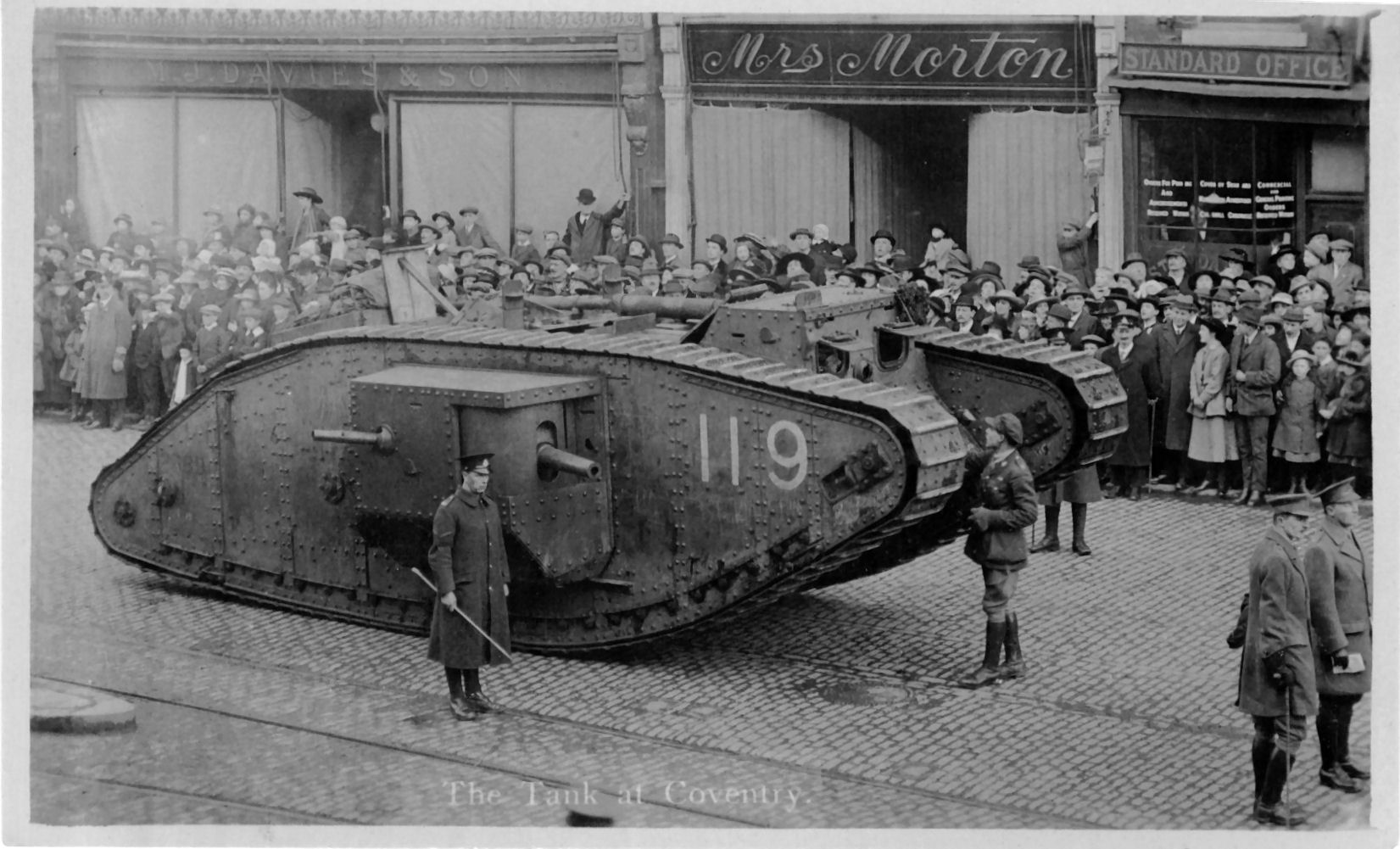
The Tank in Broadgate. During the first world war (1814-18) the Army exhibited tanks like these in all the major cities. This was no-doubt to boost flagging morale but they also asked for subscriptions to fund the production of these weapons. After the war one was given to each city and Coventry's tank stood on Greyfriars green until recycled in 1940. This model was built in Lincoln.
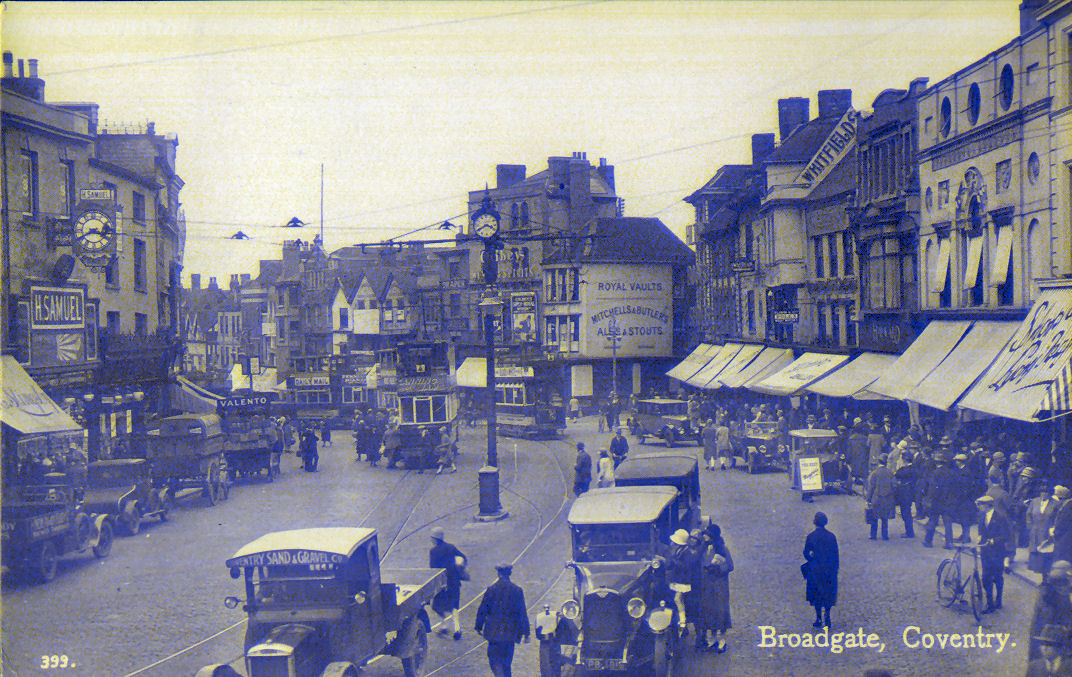
This is probably after the Great War about 1920. Note the girl with a Flower Pot hat climbing on the running board of the car. There are many motorised vehicles and only one horse-drawn cart. The scene is set in the middle of a busy afternoon. Note H. Samuel the jeweller with a clock on the wall and a clock on a post in the middle of the tramways. Note also the canvas awnings which adorned every shop in those days. The ladies skirts are now much shorter. The Royal Vaults is still in evidence but is now a Mitchells & Butlers house.
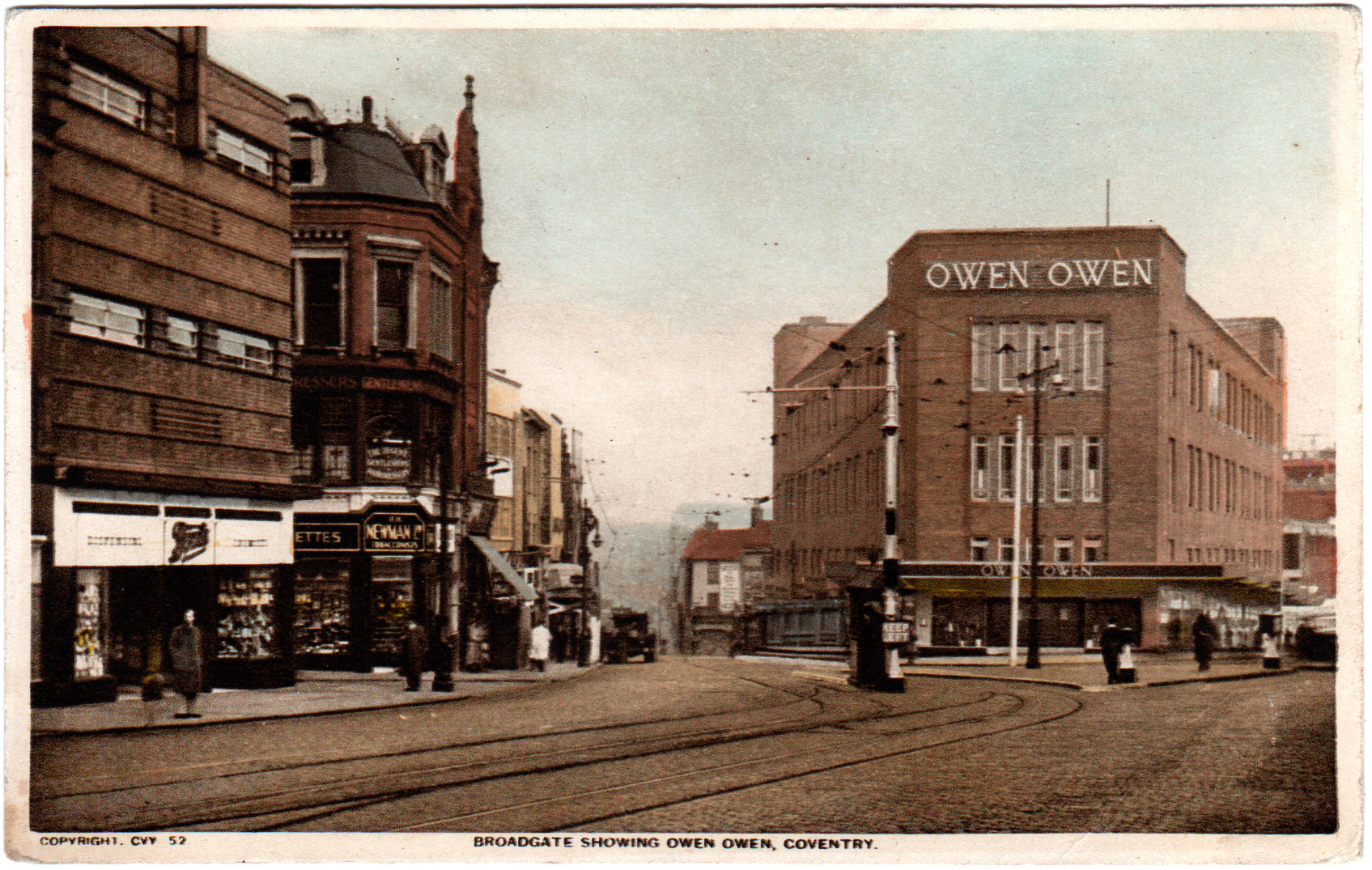
Major changes had already taken place by 1939. Butcher Row had been had been cleared together with several other streets and Trinity Street had been built with this building facing onto Broadgate. Owen Owen was one of the better stores in the city for 60 years. This building survived only one year until 14th November 1940. Boots, on the left appear to have made a pig's ear of their shop front.
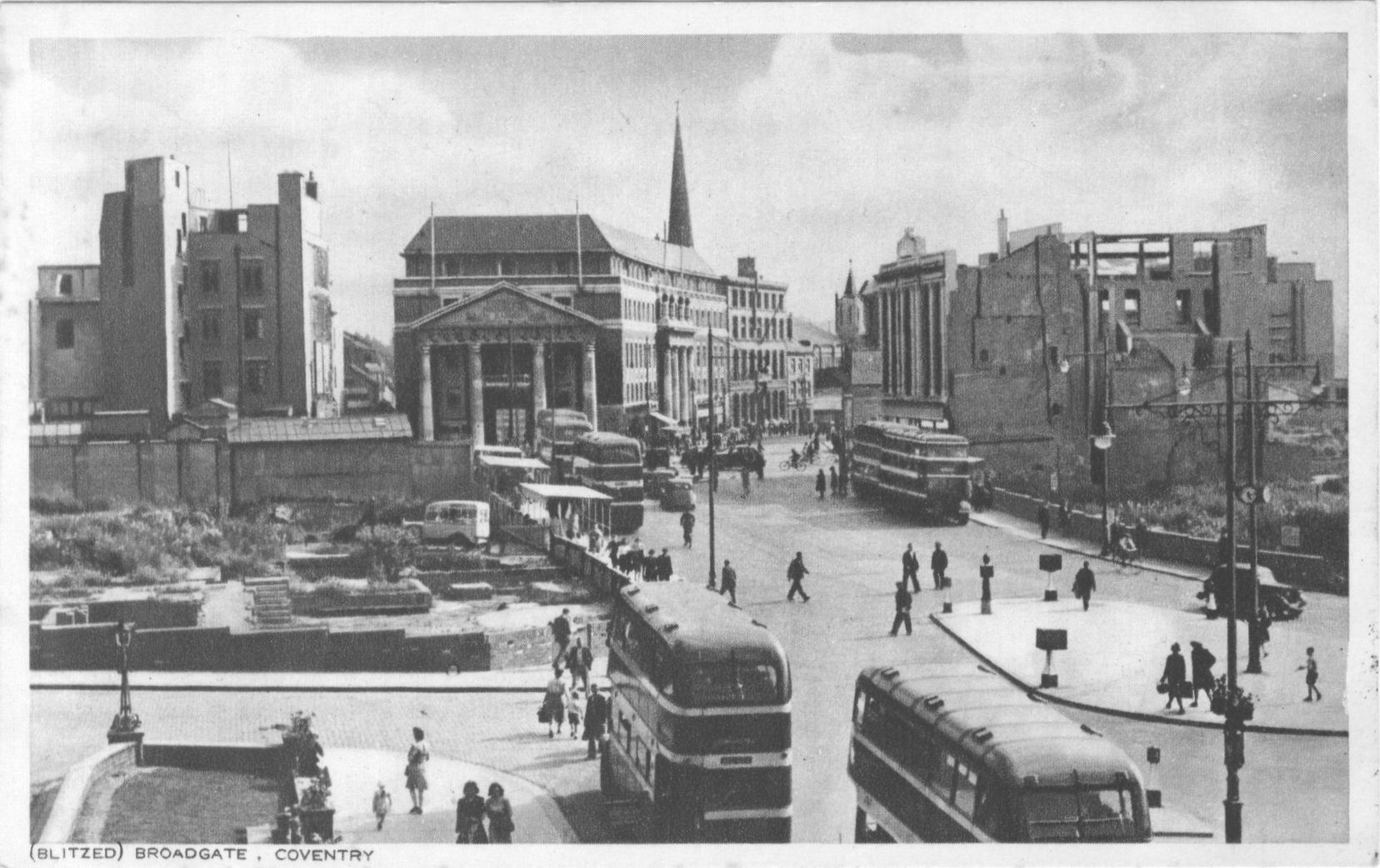
This was Broadgate after some of the blitz debris had been cleared. On the left is the Martins Bank building which survived into the 1980's and the National Westminster Bank which stands relatively unscathed. Virtually all the other buildings in Broadgate were demolished then or shortly after. The flower bed bottom left is the site of Butcher Row which had been demolished in 1936.
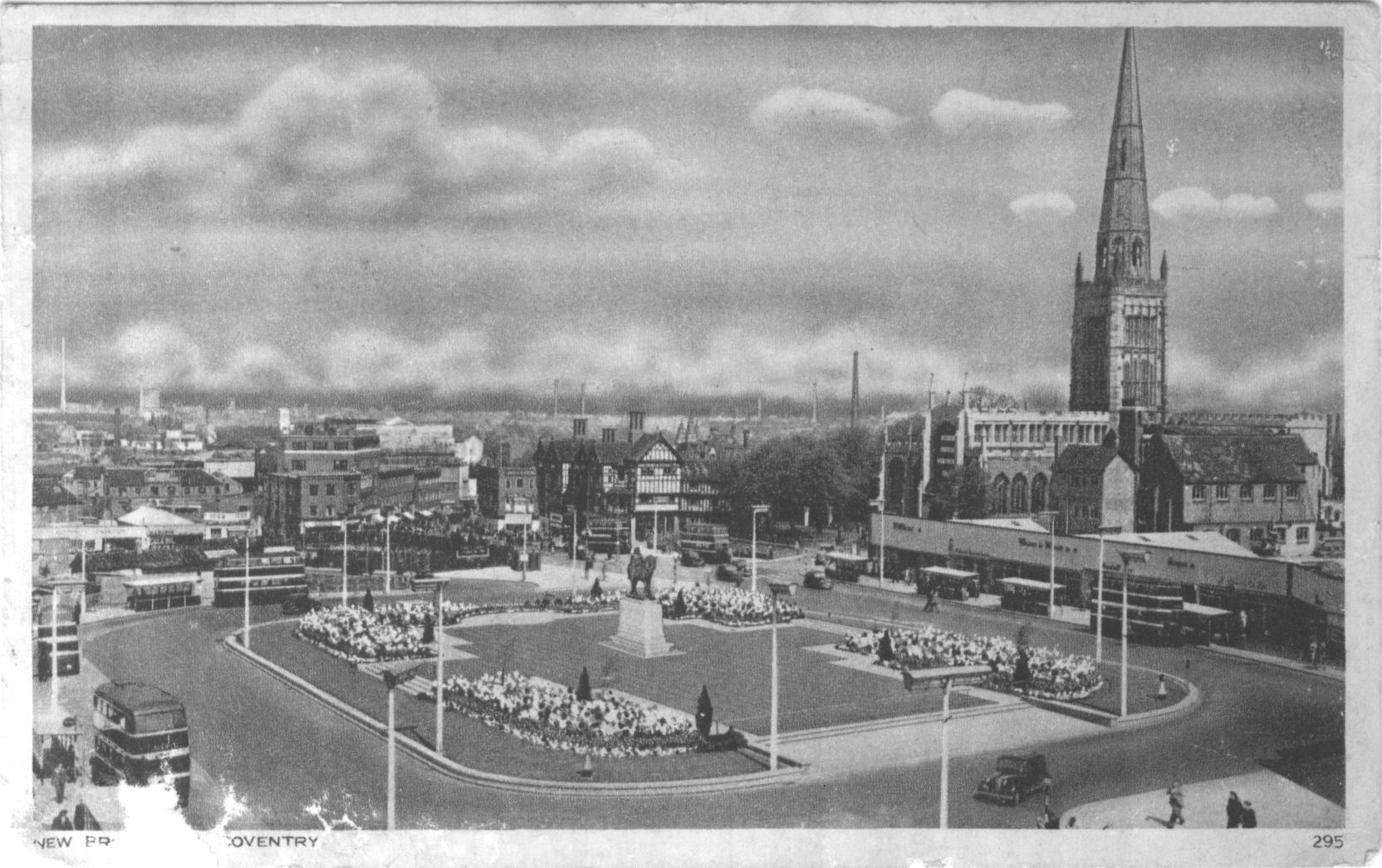
This was the early rebuilding of Broadgate after the war. The square has been much enlarged and the centre piece is lawn and flower beds with a commissioned statue of Godiva in the middle. No one, and I mean no one, ever trespassed on this garden. The people considered it represented the rebirth of the city and was declared sacrosanct; not by authority but by the actions of the people. On the right are the asbestos prefab 'temporary' shops which lasted until the early 1970's. Beyond the island the Owen Owen store (now Primark) has not started construction. Note the large number of bus stops and the virtual absence of cars. This was post-war Britain. Note the John Gulson library building in Trinity Lane, on the right, and the old jailhouse in front of it. Timothy Whites & Taylors, dead centre, is now Weatherspoons.
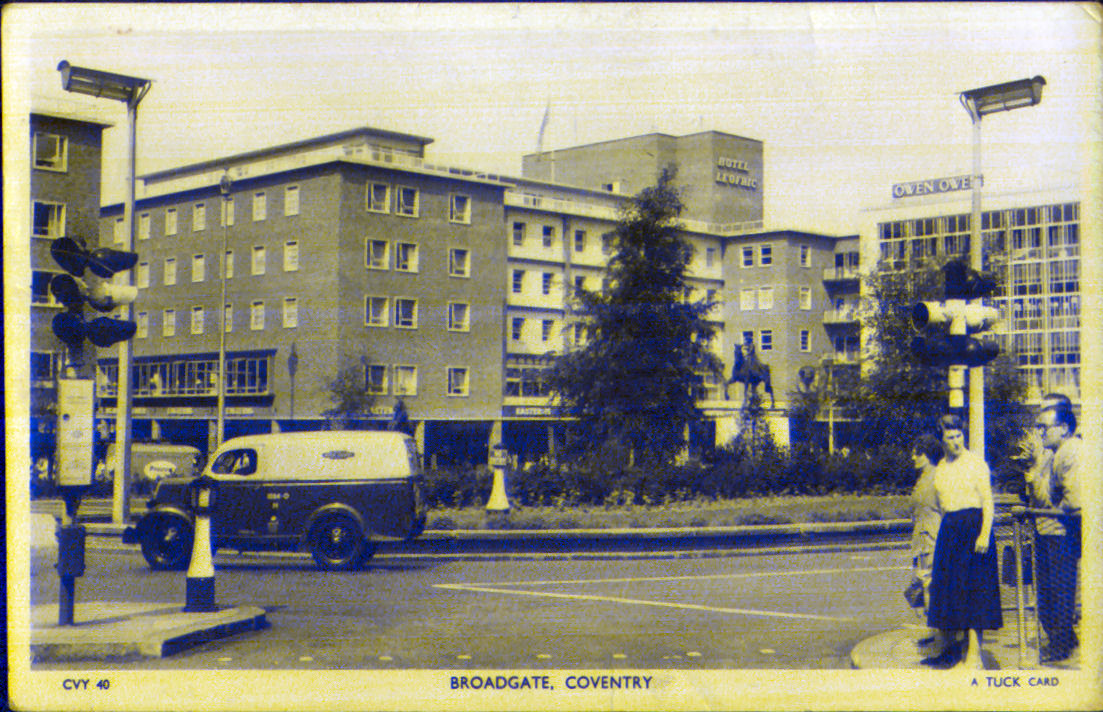
By 1960 The Hotel Leofric and Owen Owen were built and the precinct was largely finished. The poverty of post-war Britain was giving way to the swinging sixties and money began to flow a little more freely.
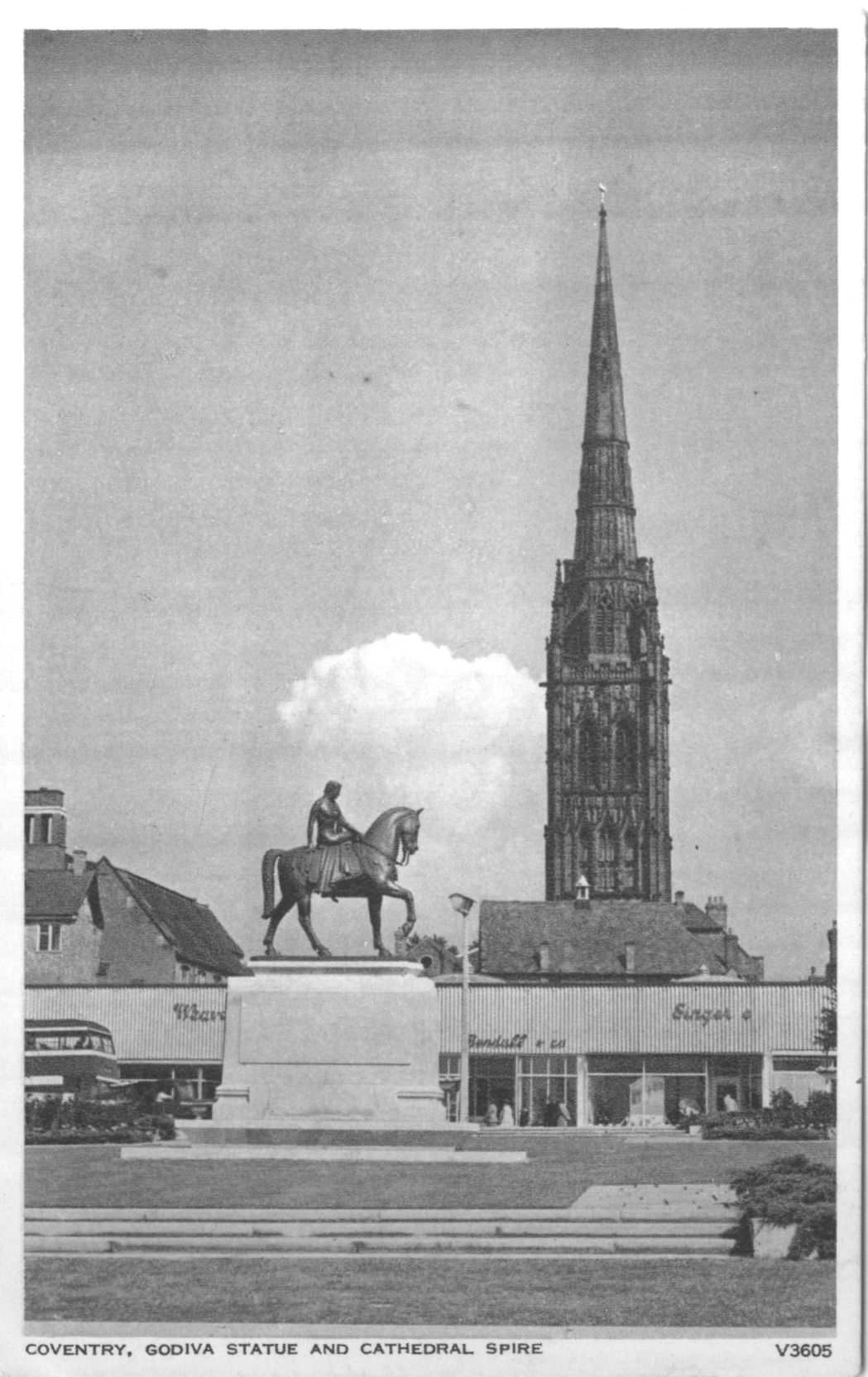
The second focus of life in Coventry has for a millennium been Godiva. The Statue by Sir William Reid Dick was unveiled in 1949. The spire of the cathedral of St. Micheal's forms the centre piece of the view along the new precinct which followed largely the line of the former Smithford Street and lined up exactly with St Michael's spire.
Lady Godiva

This was the most used image in the many cards of Godiva. The image is a copy of the small statue in St. Mary's Hall with much artwork modification. The background is a montage of various medieval building of which Coventry had several thousand as late as 1900. The church is the tower of St. John's in Fleet Street.

The Godiva Procession was held every four years from Victorian times until around 1970 and was in the early part of the 20th century one of the most popular carnivals in Britain. The 1907 carnival shown here was the biggest of them all. Godiva was played by a professional actress Patsy Montague whose stage name was La Milo. These photos were taken early in the carnival and rushed back to the studios and cards would be on sale early in the afternoon.
This picture is in Queens Road and the building in the background was the factory of Alfred Herbert. He came from Leicester around 1880 and started making machine tools. By the 1940's his was the biggest machine tool company on earth. It died around 1985. The name can just be discerned on the top of the facade. Note the access ladder which would earn its owner a jail sentence now.
After the Great War thousand of workers were laid off and many formed their own companies and turned Coventry into the most concentrated manufacturing city in England - which is why Hitler found it so attractive 22 years later as a target for his bombers.
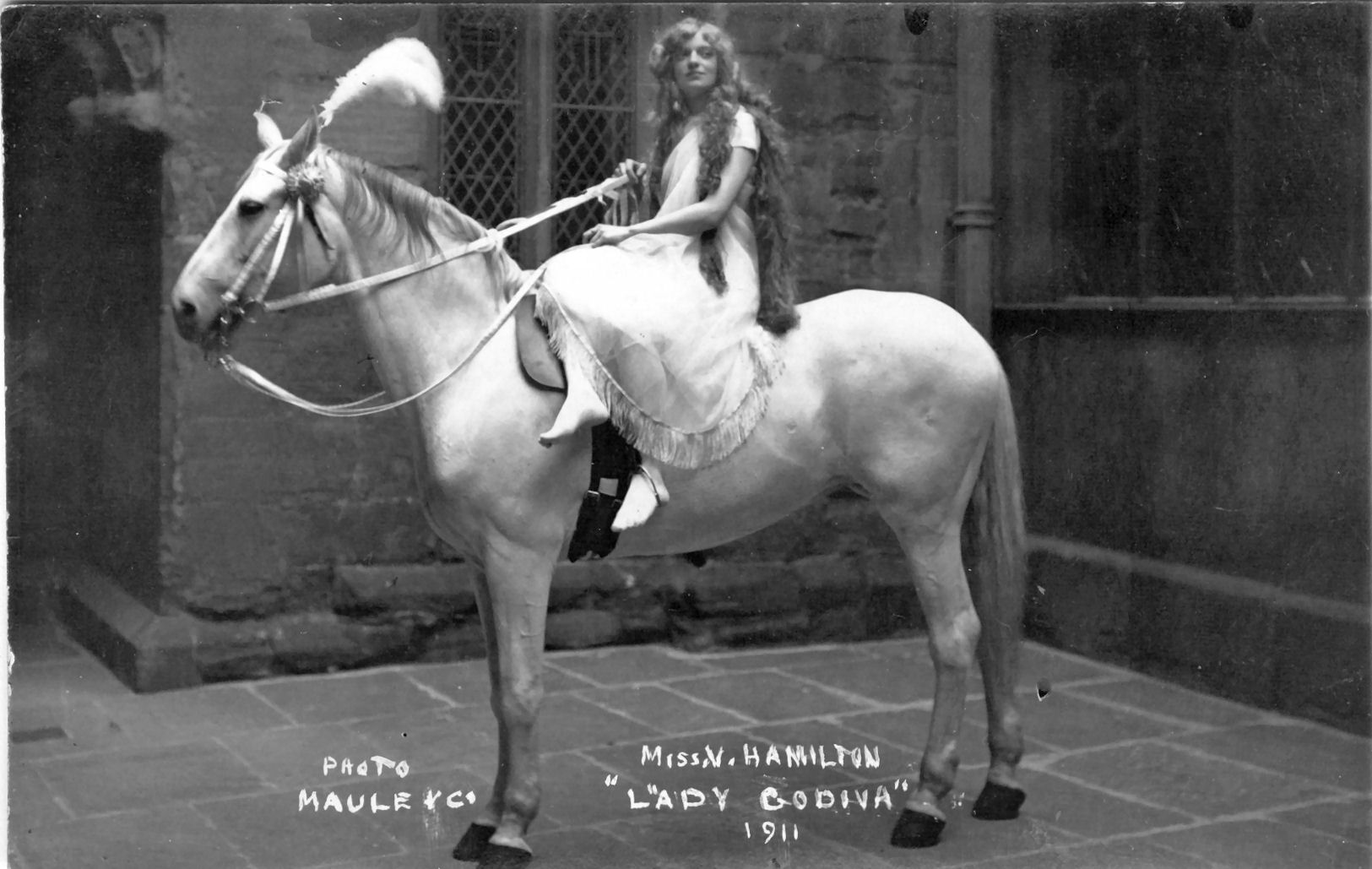
In 1911 Godiva was played by Miss Viola Hamilton a very good looking young lady who determined to make the best of her one- day appearance. This is in the the traditional assembly point of the courtyard of St. Mary's Hall.
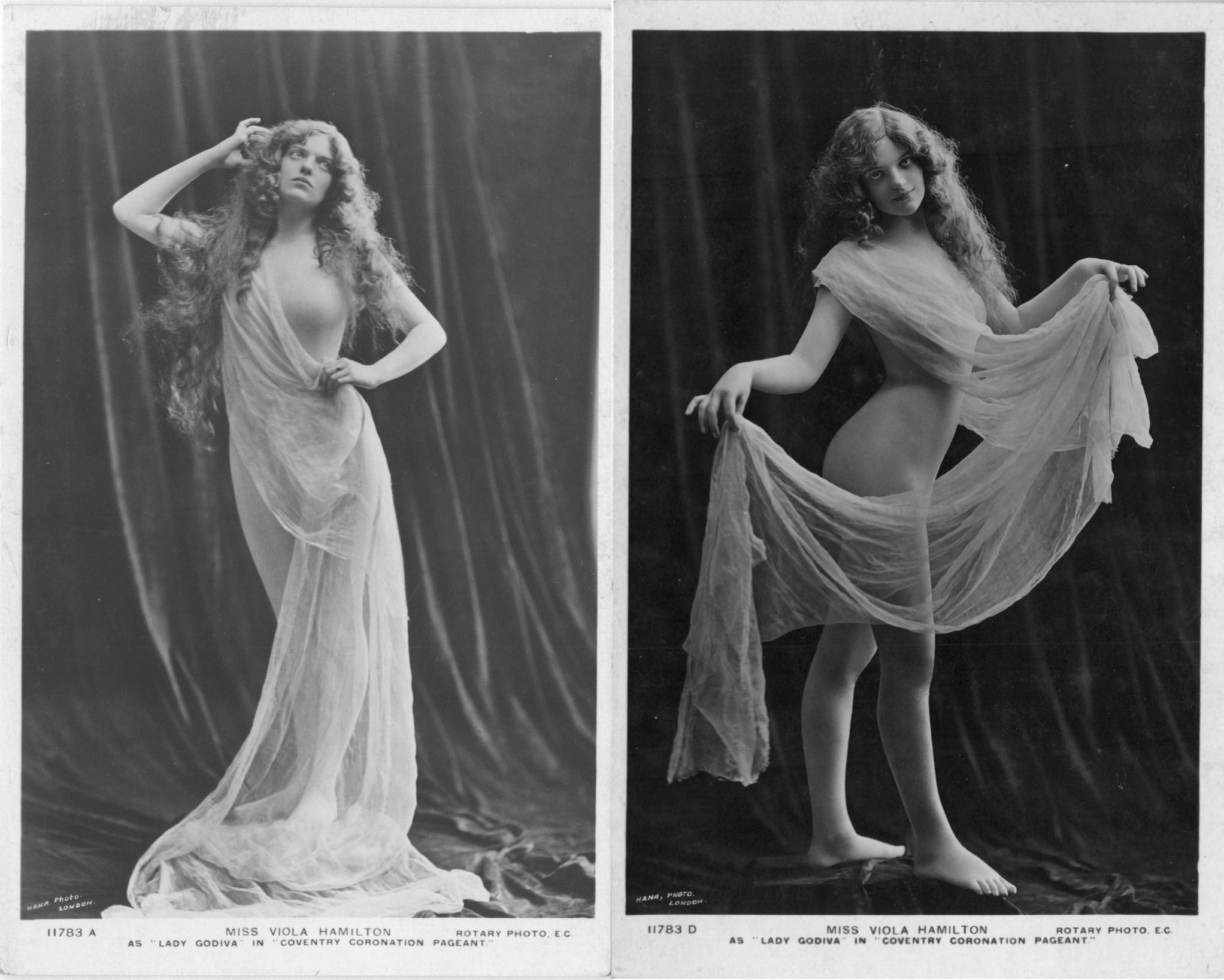
She determined to put together her portfolio and had taken and published a good number of photographs, some of which are nearly pornographic but still rather nice.
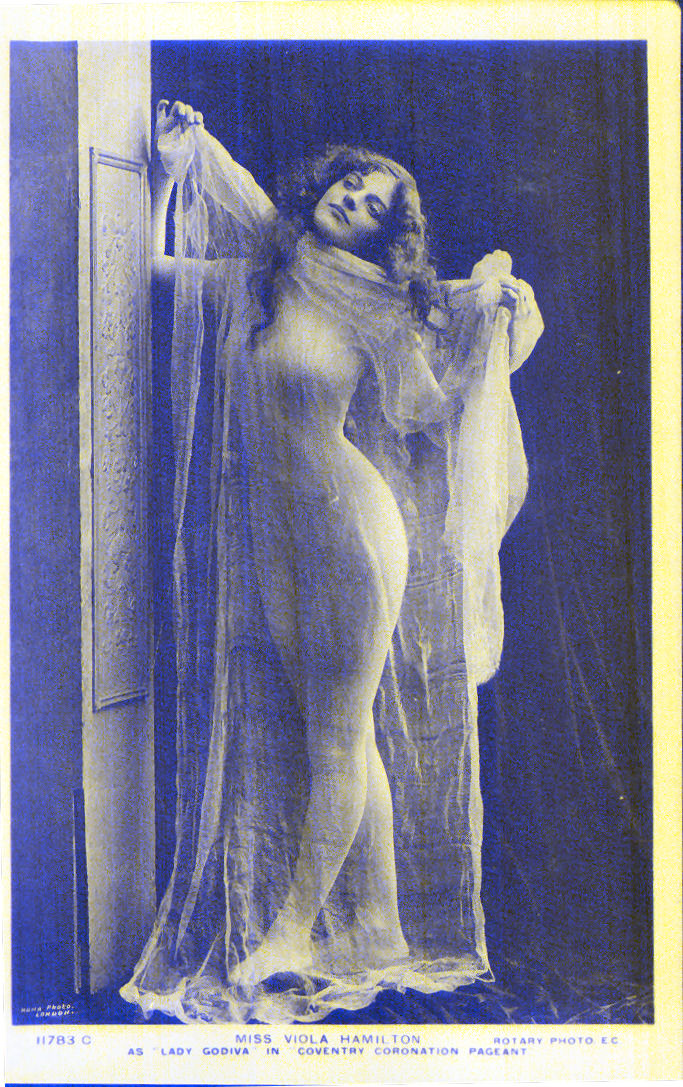
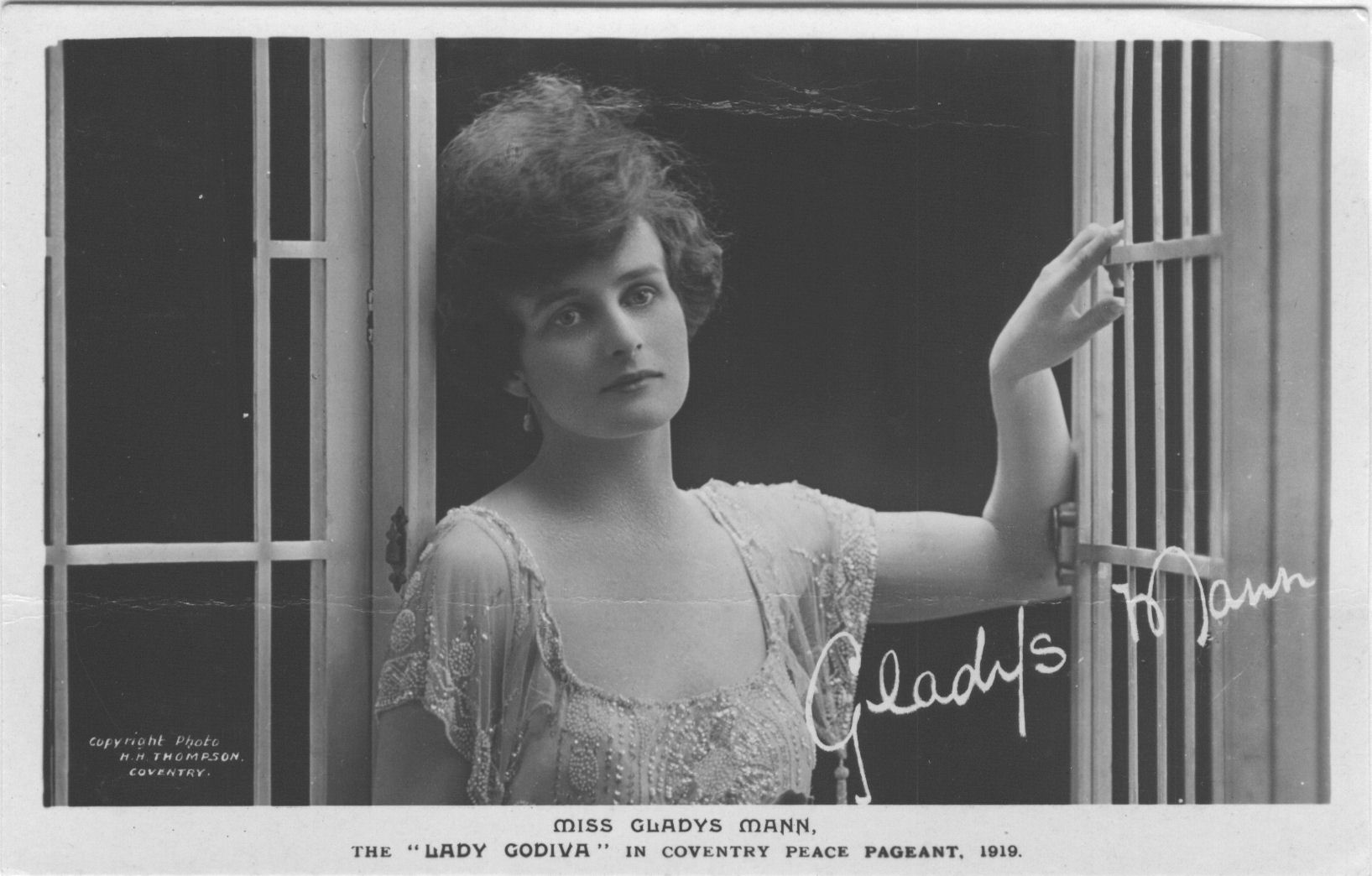
After the Great War the first carnival host in 1919 was Gladys Mann
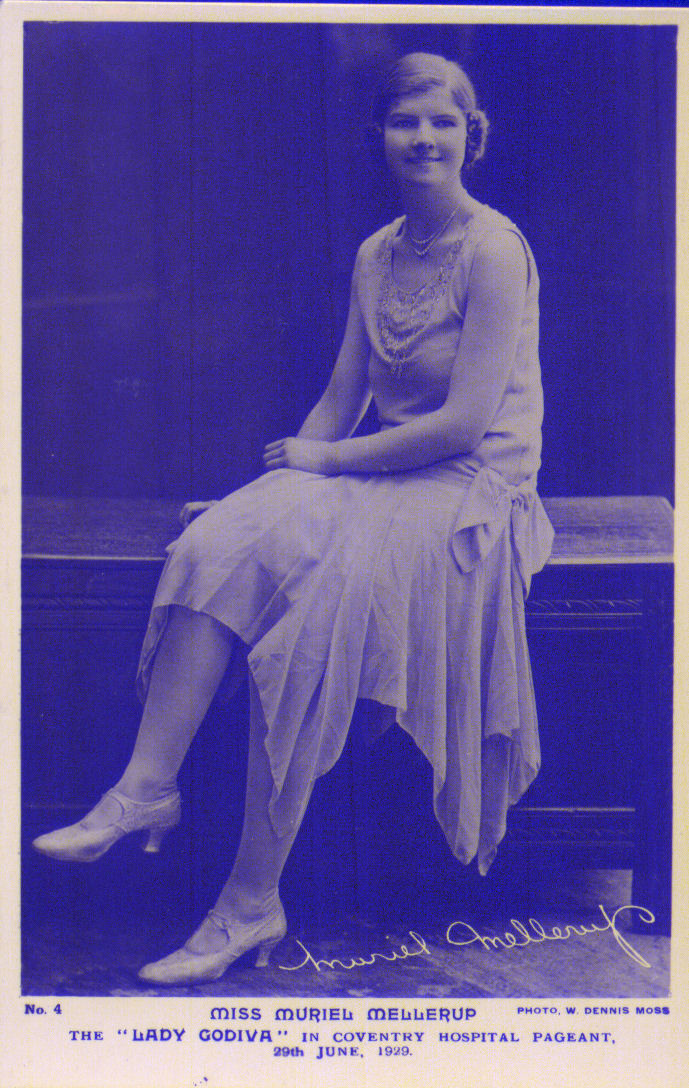
In 1929 the role was played by a local girl Miss Muriel Mellerup.
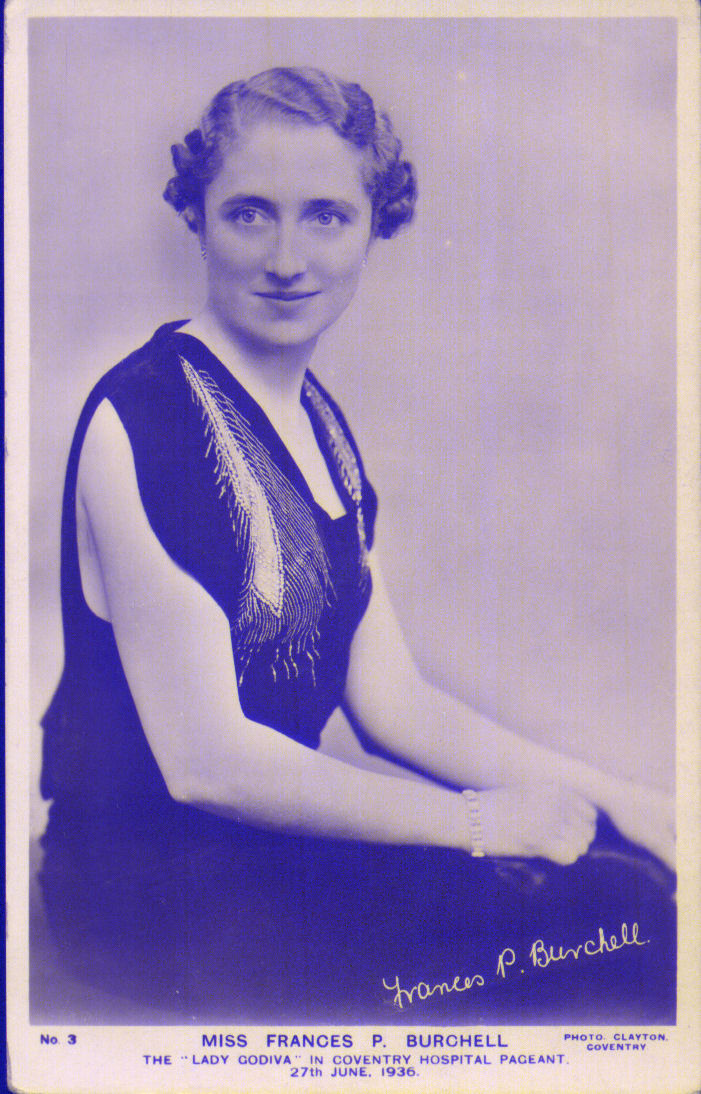
And in 1936 Miss Francis Burchell. The permed hair style could could hardly have belonged to any other era.
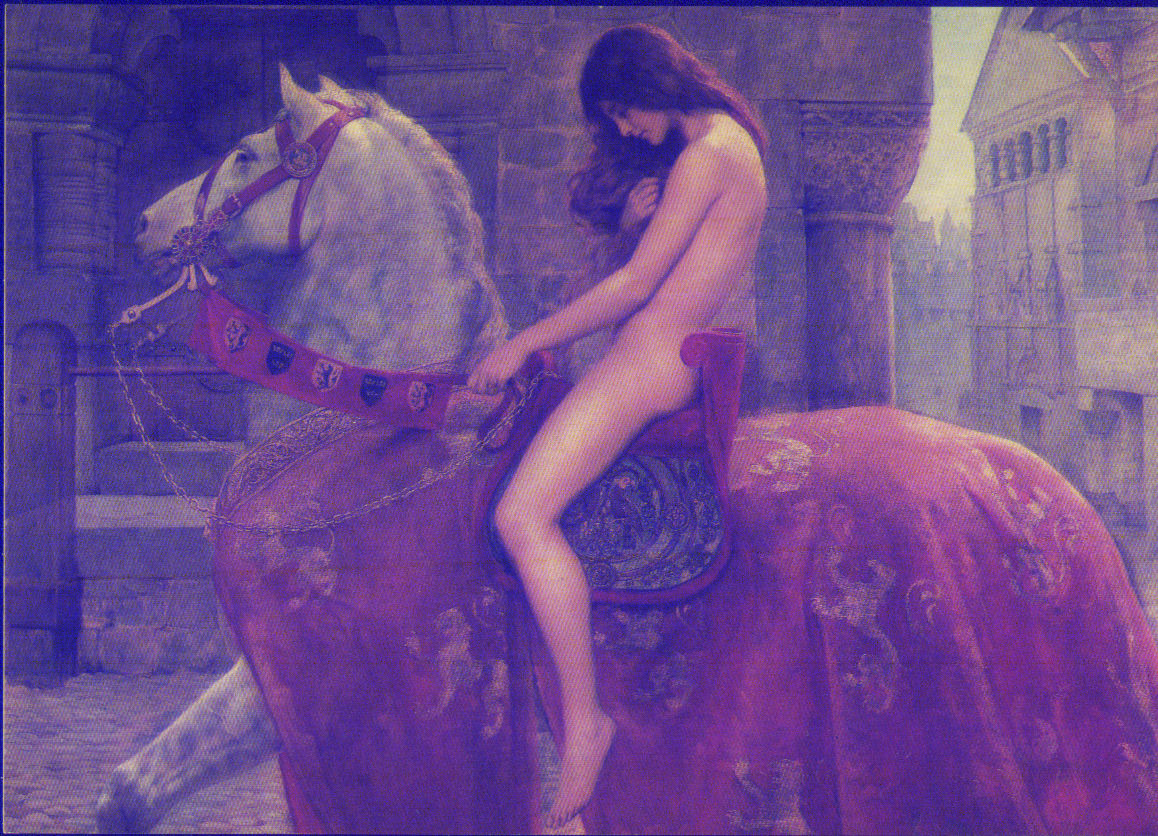
This is how Godiva would have looked had she ridden naked through the city. The vast majority of pictures and cards show her riding side-saddle but she lived in the 11th century and side-saddle was not invented until the Victorian Bustle made sitting astride a horse virtually impossible.
But, sorry fellers, Godiva never rode naked through Coventry. She was a Countess and her Husband was Earl Leofric, one of the most powerful men in Mercia and England. The records say she " rode stripped of her finery". What this means is that she wore ordinary common clothes instead of her regal robes to go out in public. This would have been a real insult to her husband and presumably achieved the desired result.
Europe in medieval times was full of stories of naked ladies riding white horses and they were, of course, fertility rites.
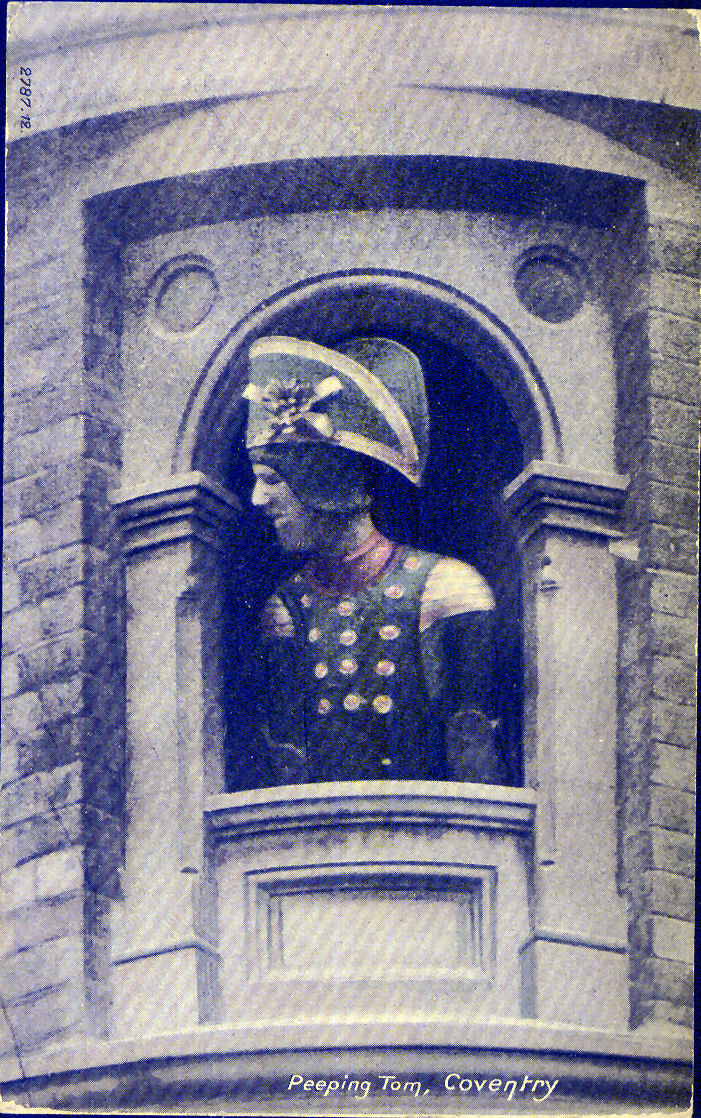
Peeping Tom was very clearly a Victorian invention. His uniform looks like a navy and army conglomerate and that hat is quite unbelievable. If he existed at all he was a peasant in medieval 11th century England and certainly would never have seen, let alone worn, a uniform.
The Godiva legend is only partly true; but I don't care. I may be getting long in the tooth but I still don't mind looking at naked ladies on white horses. Long may it continue.
Coventry Churches
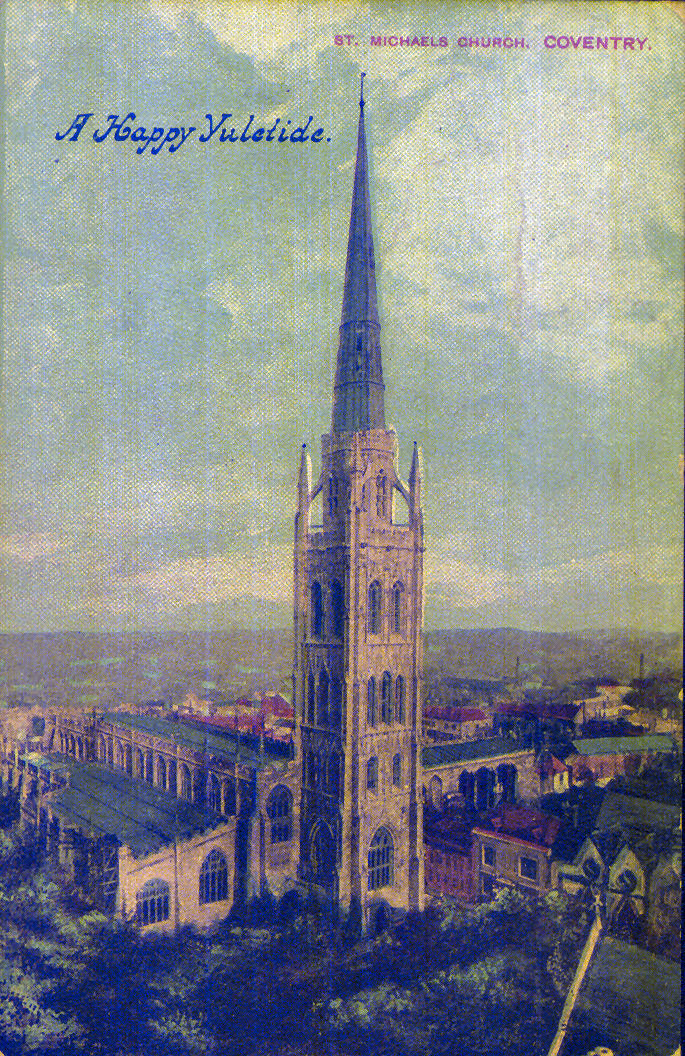
St. Michael's was the biggest parish church in England. Coventry had had a cathedral in 1043 but Henry VIII had destroyed it in the reformation. The church became the second Coventry Cathedral in 1919. The spire was the last of the great Perpendicular style and the third highest in the land and the church was one of the lightest and brightest. Its leaded windows were made by local artist John Thornton who went on to make the huge East Window in York Minster.
Dr. Jonothan Foyle of The World Monument Fund has recently led a project to restore about 8000 recovered pieces of the cathedral glass. He believes the remainder was buried in the crypt under the cathedral in 1940. The pieces now available were in Victorian screens which had been made with pieces taken from the church, presumably during routine maintenance. The screens had been stored in Hampton Lucy in 1939 but were forgotten for thirty years during which time they made several long journeys. They are, at last, back in the third Coventry Cathedral. They are a national treasure.
There are alleged to be windows from Coventry Cathedral in Iceland and South Africa and probably elsewhere. Dr. Foyle believes that London Spivs sold glass from dozens of destroyed London churches as being from the infamous raid on Coventry.
Note also the overprinting with a Yuletide message. Christmas cards were very expensive for ordinary people in 1900 but Post Cards were a penny each. Overprinted cards for Christmas were quite common.
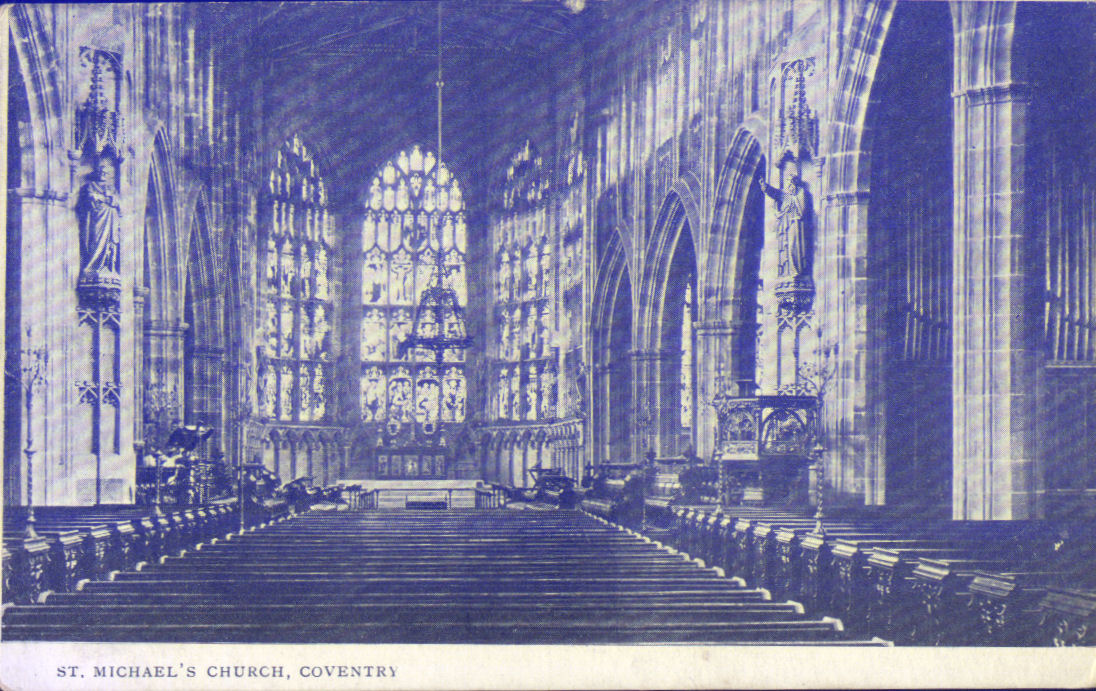
The interior of the church was bright and airy and the windows magnificent. there were also dozens of valuable sacred objects, many of which were removed on the night of the blitz.
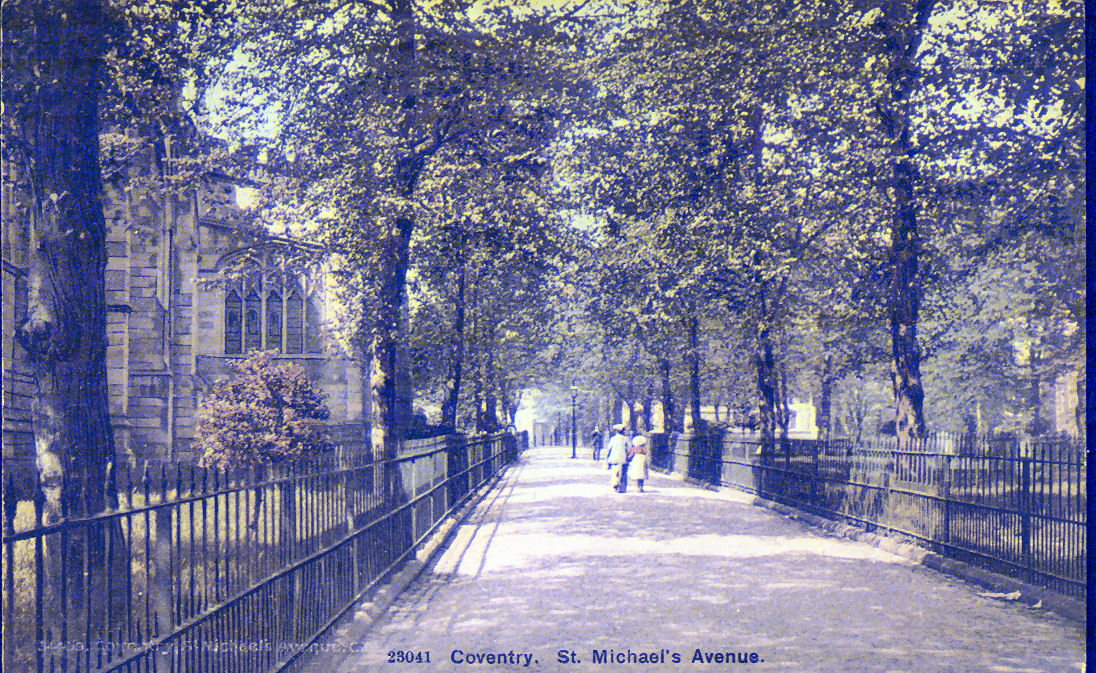
The view of St. Michael's Avenue has not changed much today but it seems impossible to equal the excellence of the nineteenth century photographers.
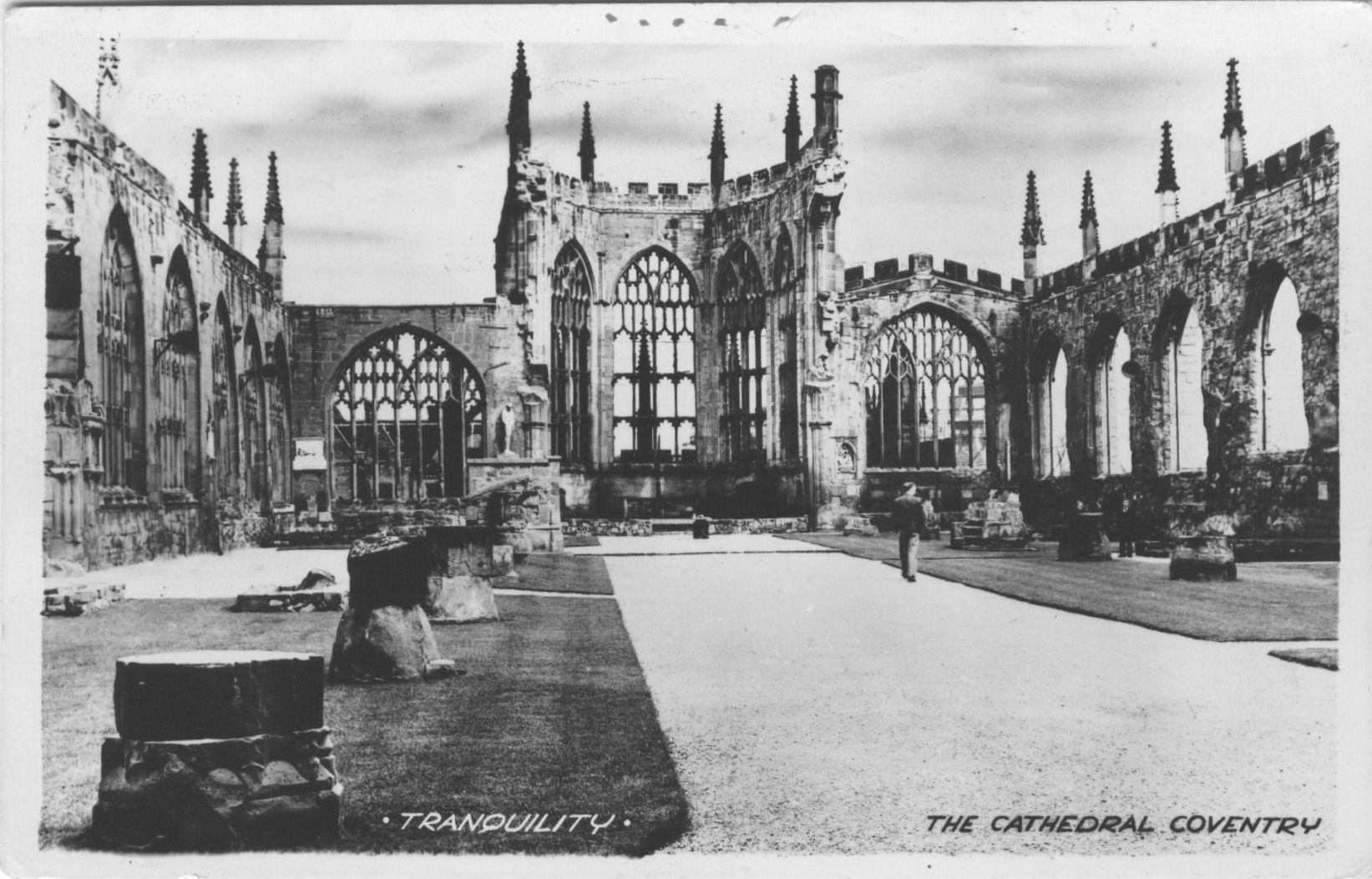
The ruins are still part of the Cathedral and are dedicated to Peace and Reconciliation. They are currently (2014) undergoing extensive repairs.
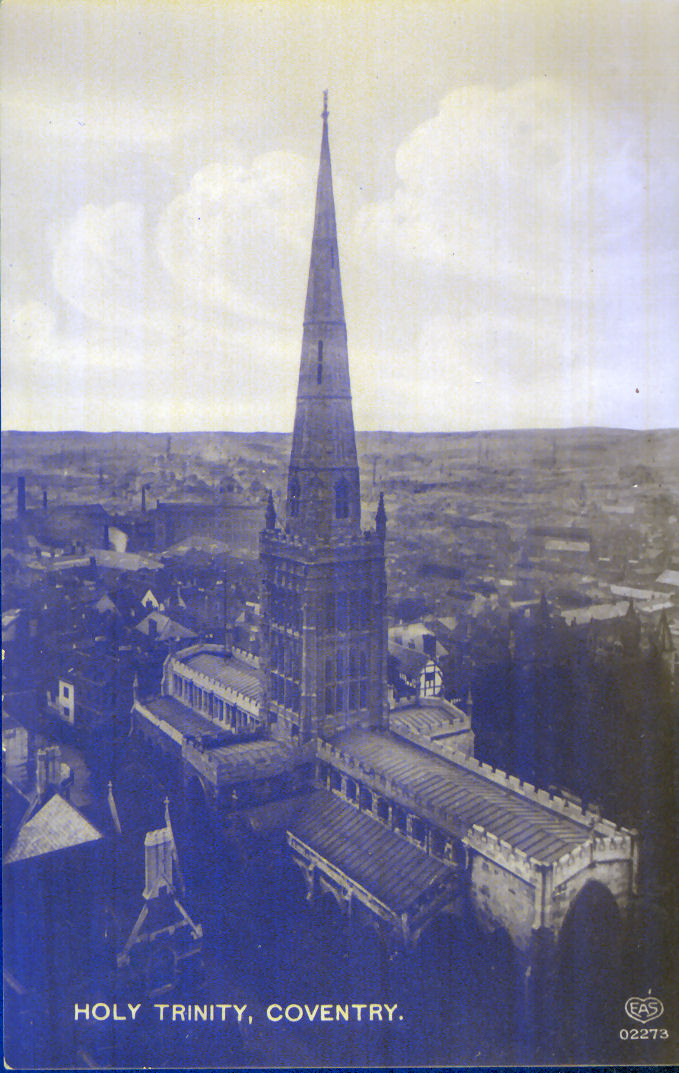
Holy Trinity Church has its origins in the 12th century and was associated with the nearby St. Mary's Priory. It suffered in the reformation but survived and has served the city ever since. Its painted walls were whitewashed by the Puritans but a superb Doom Painting has recently been uncovered. It is a beautiful church.
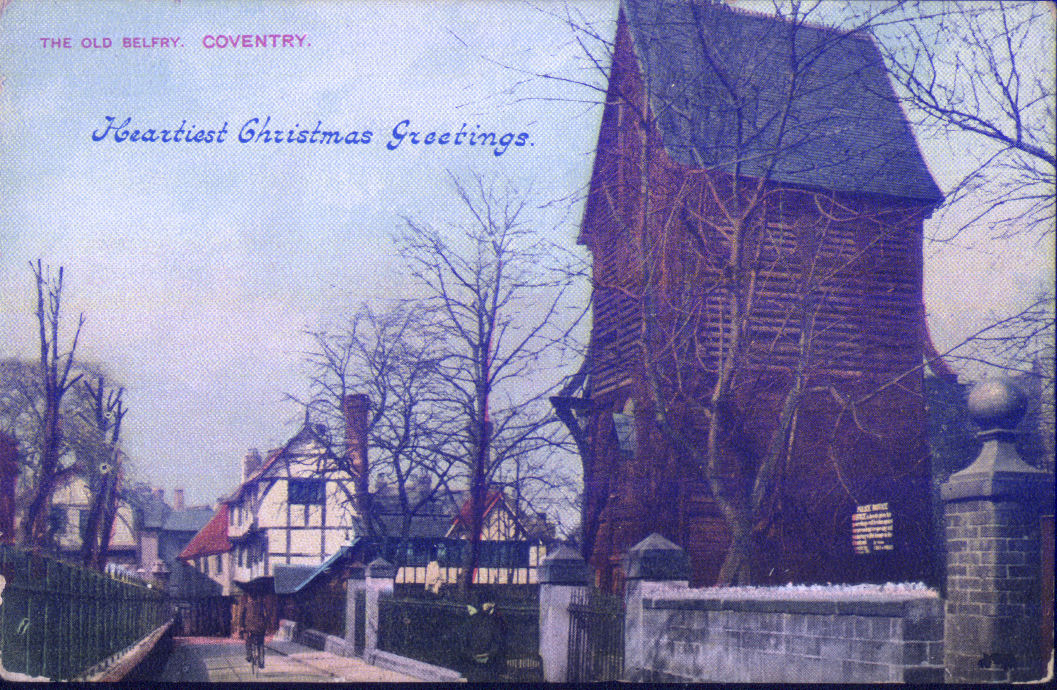
In the 19th century the bells were removed from the church tower as it proved to be not strong enough. This Belfry was built nearby in Priory Row. It was removed around 1970 and the bells are thought to be in Australia.

St Micheal's Baptist church was built at the junction of Bayley Lane, Hay Lane, Pepper Lane and Cuckoo Lane, next to St Micheal's Parish church. It was completely destroyed in the blitz.
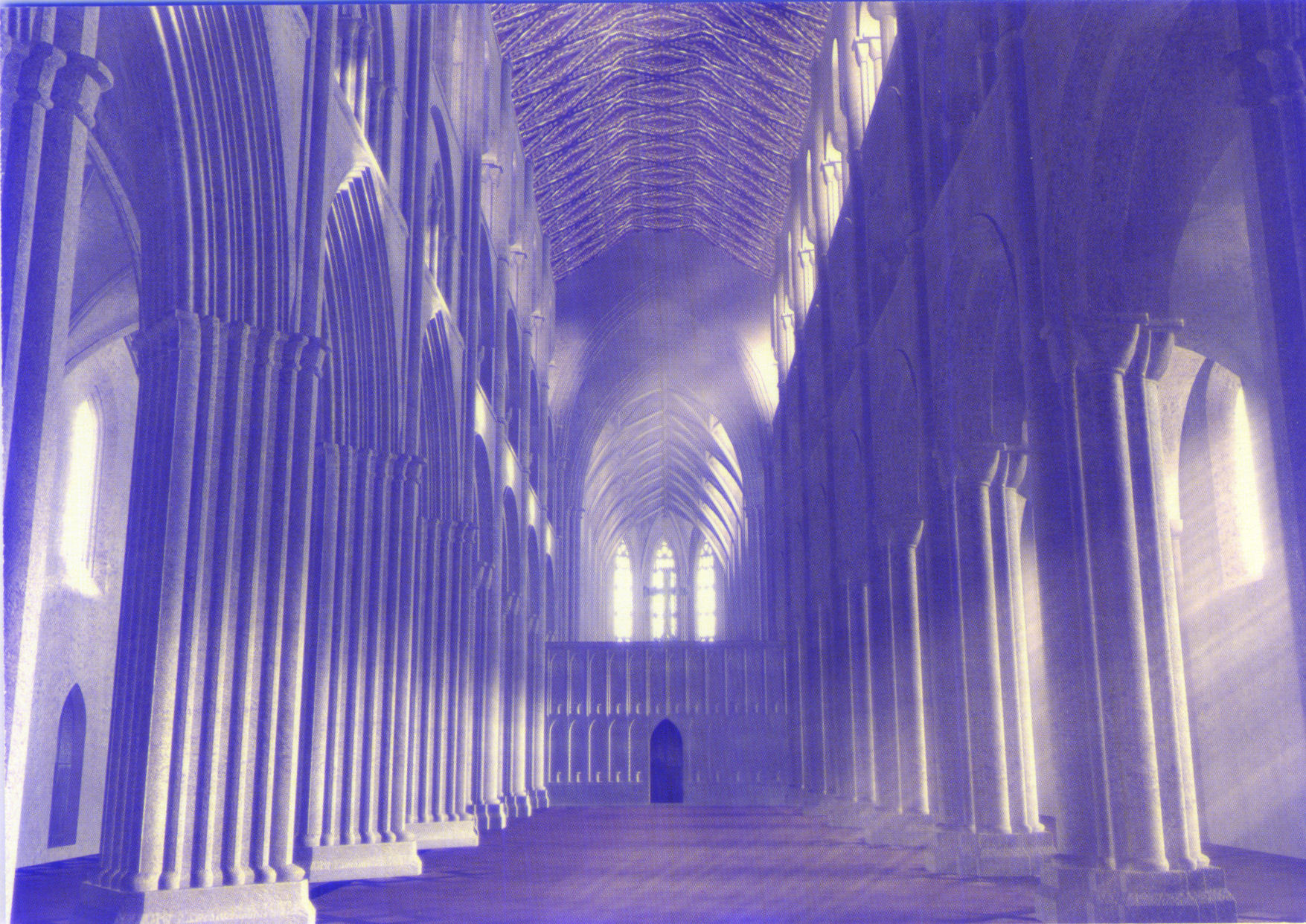
This Computer generated image of St. Mary's Priory was commissioned by city conservation officer George Demidovicz as part of the archeological excavation of the remains of St. Mary's Priory in 1999. This church is very similar to the cathedral at Lichfield which was our joint diocese for about 300 years. This building was in use by around 1150 and must have appeared as a miracle to people who were lucky to have a mud hut to live in. It was the length of Holy Trinity and St. Micheal's combined.
The Priory was founded by Leofric and Godiva in 1034 and constructed in the following hundred years. Henry the VIII sacked all the incumbents and ordered the substantial demolition of the building. There are still parts of the Priory in gardens of houses near to the city centre. The recycled sandstone no doubt made a useful contributions to the building of walls throughout the city for a considerable time.
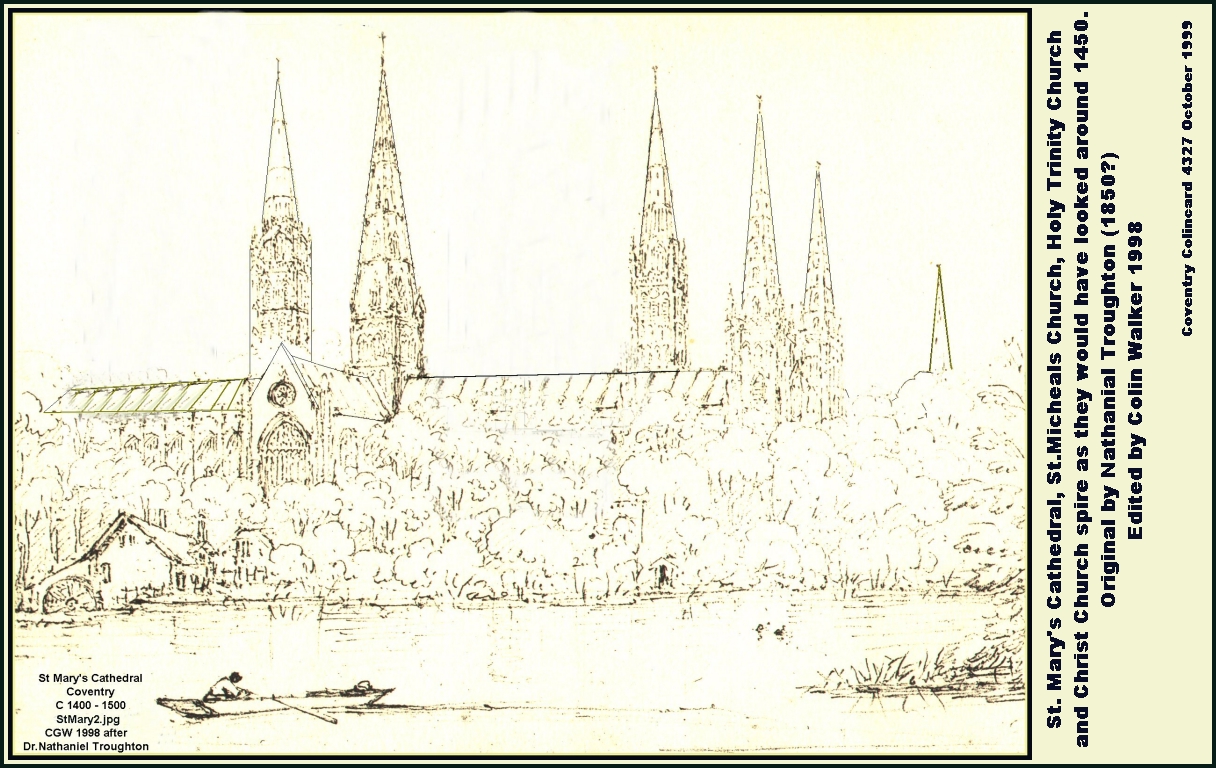
This fantasy montage of St. May's Priory is due to Dr. Nathaniel Troughton and shows six of Coventry's then seven spires. The missing one here would have been Whitefriars off to the left. This also shows the Priory Pool which we now call pool Meadow and was drained around 1830. It was part of babu Lacu which in Roman times had stretched from the site of St. John's Church to Mill Lane which is now Cox Street. The Priory Mill is also evident here. The priory ruins are on display in the Priory Centre in Priory Row.
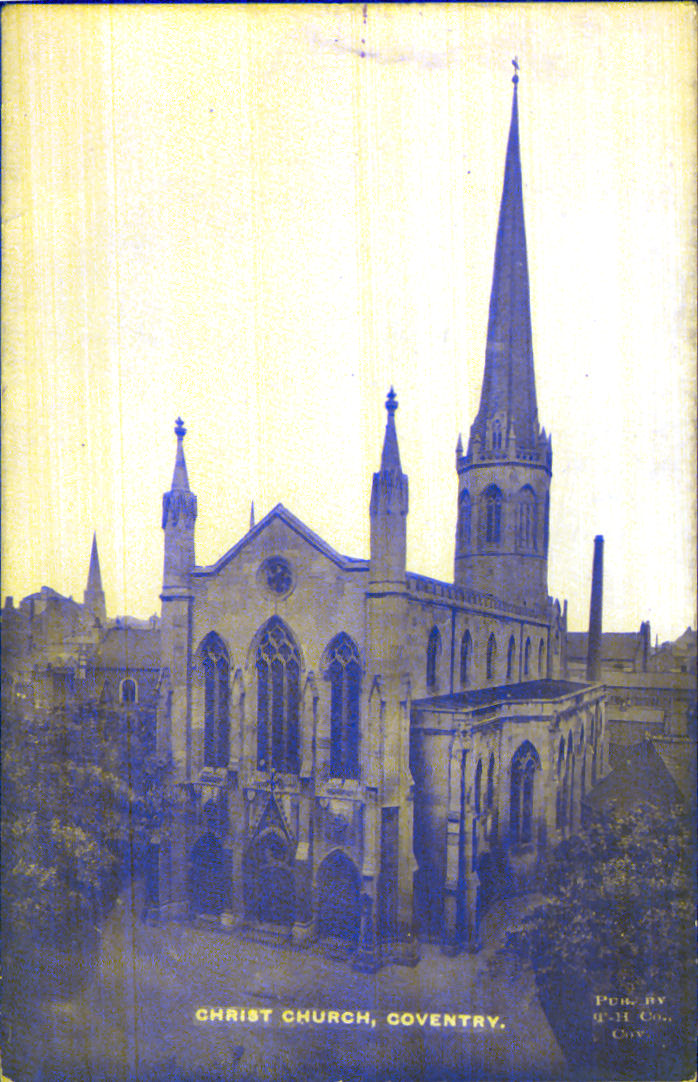
Christ Church was built by The Greyfriars in the 16th century and the spire is original. The church decayed and was rebuilt in Victorian times and style. Hitler destroyed it a second time.
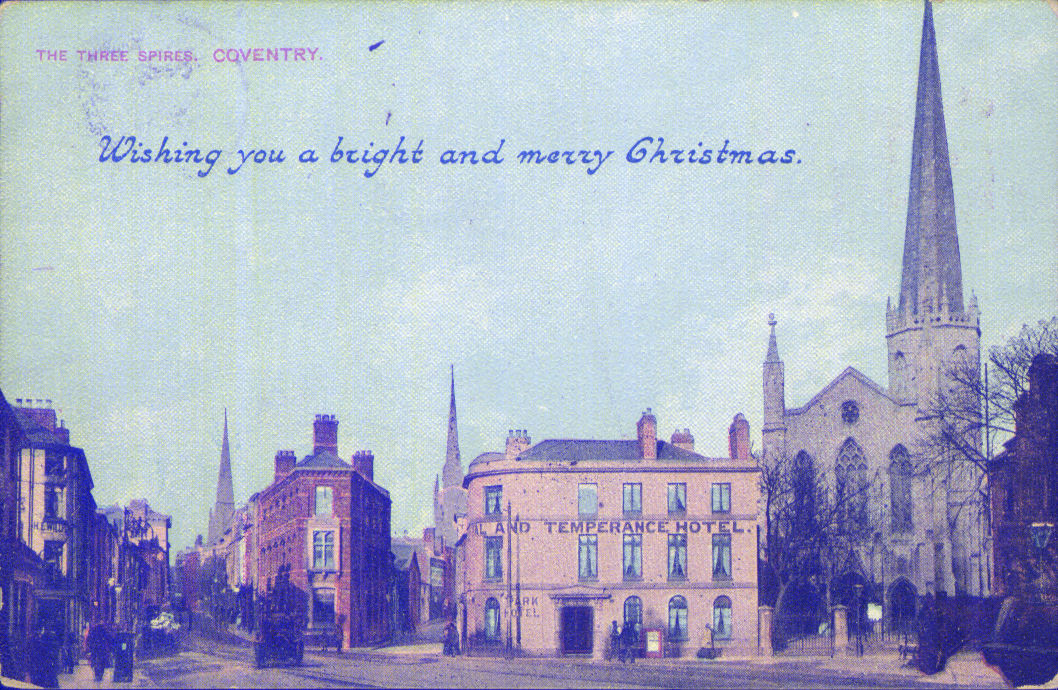
This view of Greyfriars Church also shows the three remaining spires to good effect. The Temperance Hotel in the foreground is now the site of the Methodist Central Hall.
.jpg)
St. John's Church in Fleet Street was founded by Queen Isabella around 1344 but closed by Henry VIII in 1546. The church is possibly the source of the saying "Sent to Coventry" when Royalist prisoners were held there after the civil war and shunned by local people. This is an unusual view of the rear of the church showing the courtyard of Bond's Hospital. The Church in 2005 underwent a major underpinning to transfer its great weight to bedrock under the gravels of the former Babu Lacu.
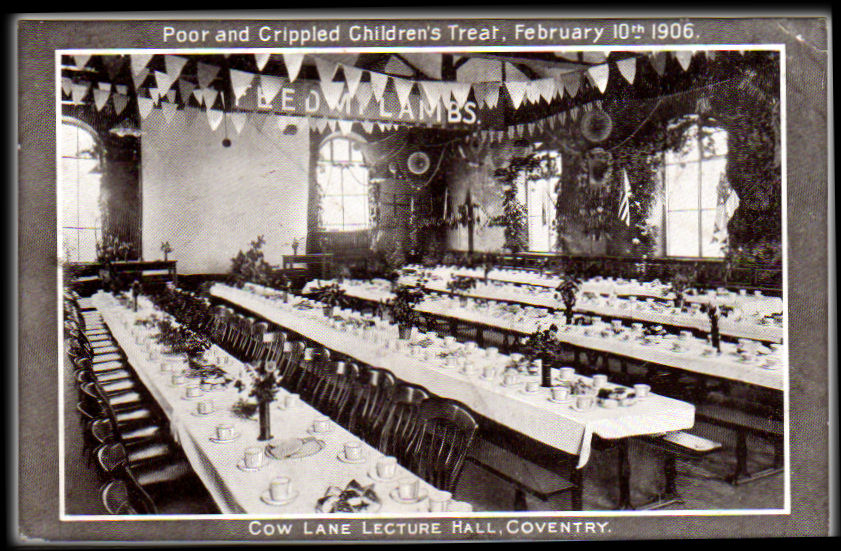
The Cow lane Assembly Hall was a methodist church hall and was an outreach of the Queens Road Baptist Church. It also established the Lord Street Sunday School when Chapelfields was developed around 1850 and that establishment moved from Lord Street to Queensland Avenue in 1928.
Buildings
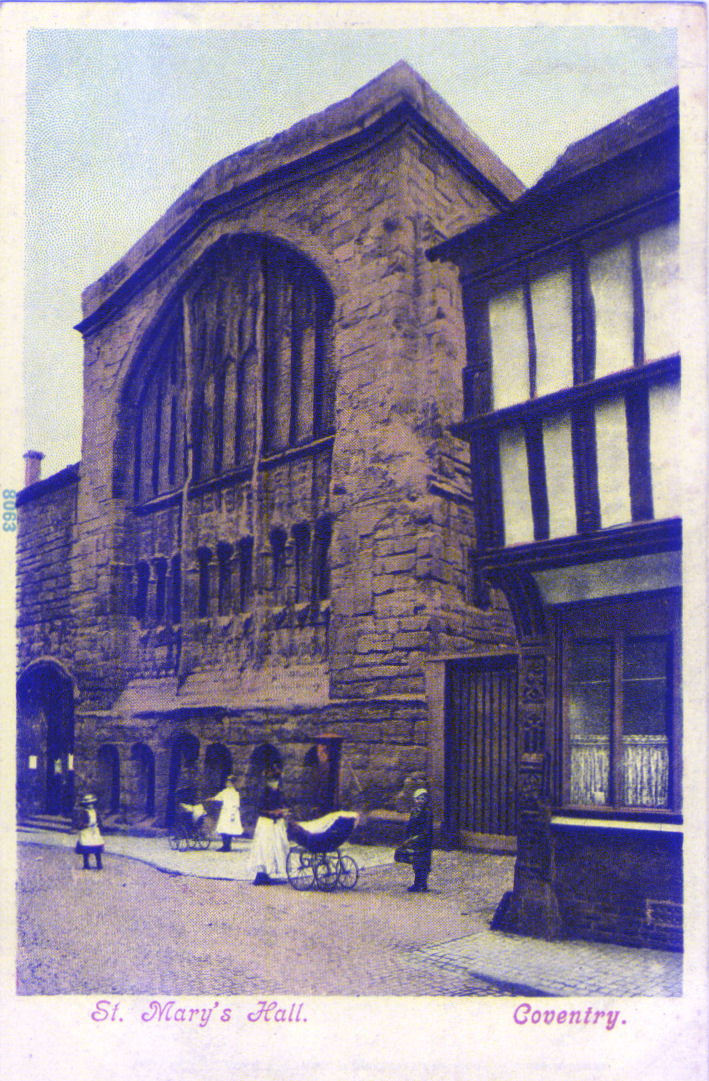
St. Mary's Hall is one of the finest buildings in Britain. It has, unfortunately, had its original floor removed but most of its other features are original. It suffered only minor damage in the blitz. The guildhall was built in 1340 and has served as the seat of local government ever since. The new(ish) Council House is connected to it. The hall has a fine ceiling of coats-of-arms and stained glass windows telling a host of stories. The much understated piece-de-resistance is the tapestry. It was made around 1495 and hung where it remains. It was made in France but illustrates the wealth of the city that bought it. It is still in remarkably good condition. There are different interpretations as to its meaning but the favourite is probably a depiction of the court of Henry VI. It has seventy five characters and many are looking at each other to send messages which only history can interpret. It is one of the most important artworks on earth but Coventry keeps it very well hidden. You will be lucky, indeed, if you can ever get to see it , but it is well worth the effort.
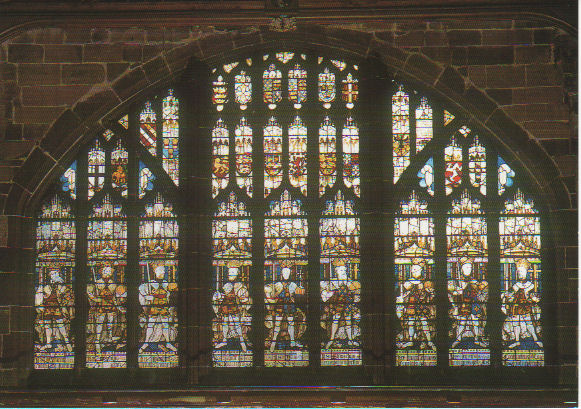
The North Window of St. Mary's Hall is just one of a number of superb features of this beautiful hall.
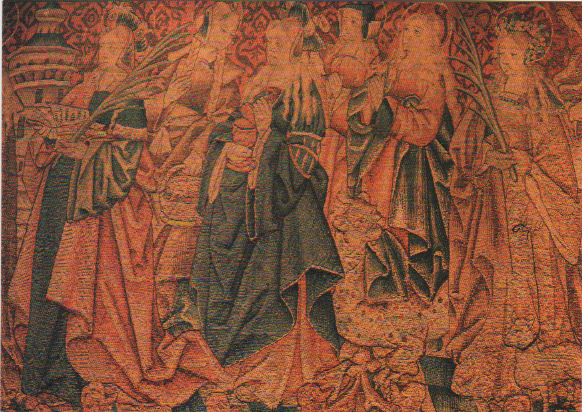
This modern post card shows just a small portion of the tapestry which fills much of the North Wall.
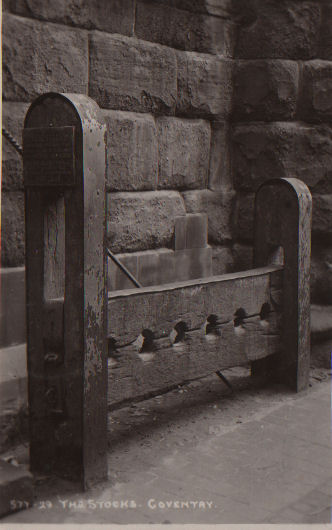
The Stocks used to be in what is now known as Castle Yard off Bayley lane but they disappeared many years ago.
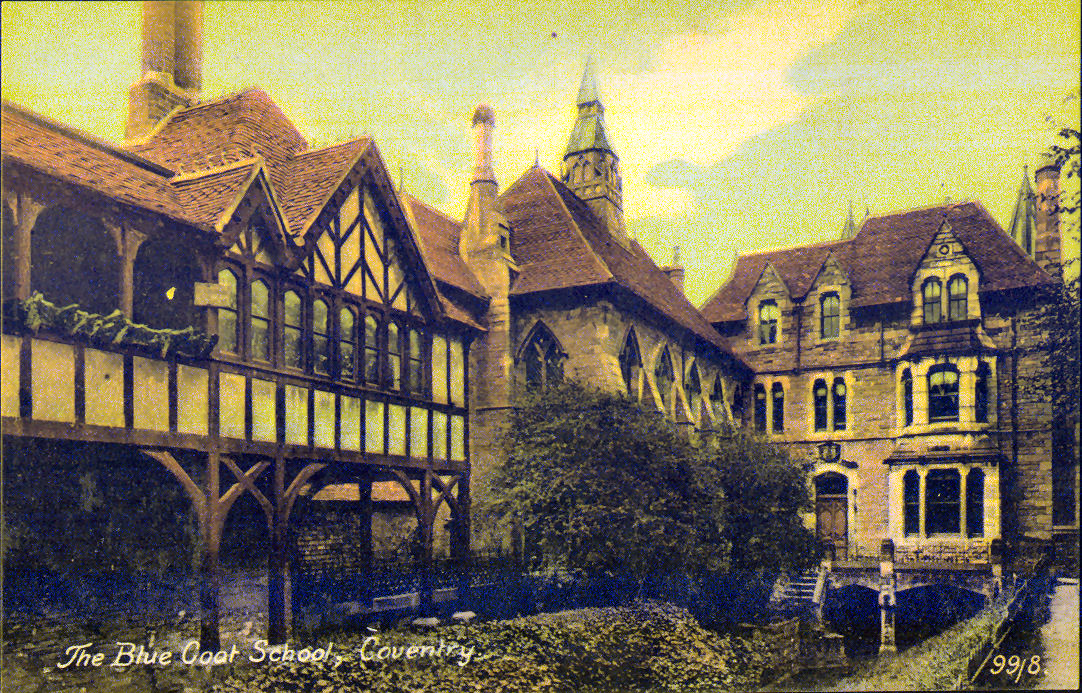
The Blue Coat School was built by the Victorians to educate their maids into domestic service. It is built upon the ruins of the forward towers of St. Mary's Priory and much of the sandstone was almost certainly recovered from the priory. It was restored by George Demidovicz working for the city council around 2005. It is now operated by Holy Trinity Church.
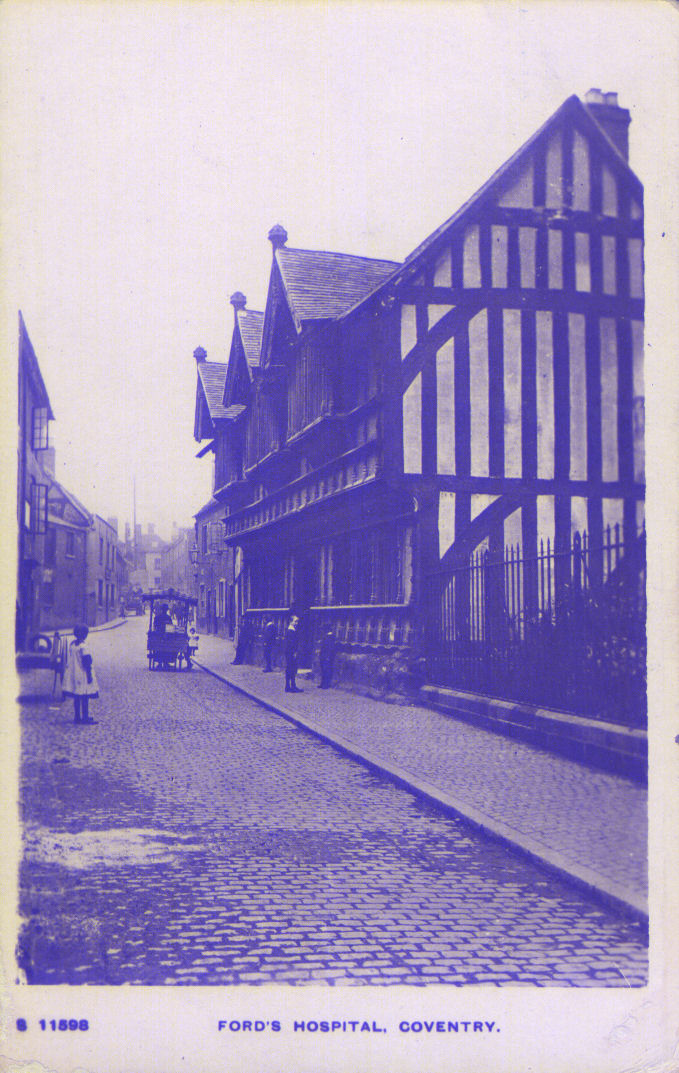
Ford's Hospital in Greyfriars Lane is thought to be one of the finest timber framed buildings in Britain. It was severely damaged in the blitz but was completely restored by Coventry City Council. It still operates as a charitable home. Greyfriars Lane was the main road into the city from the south for a millennium until by-passed by the construction of Hertford Street around 1830
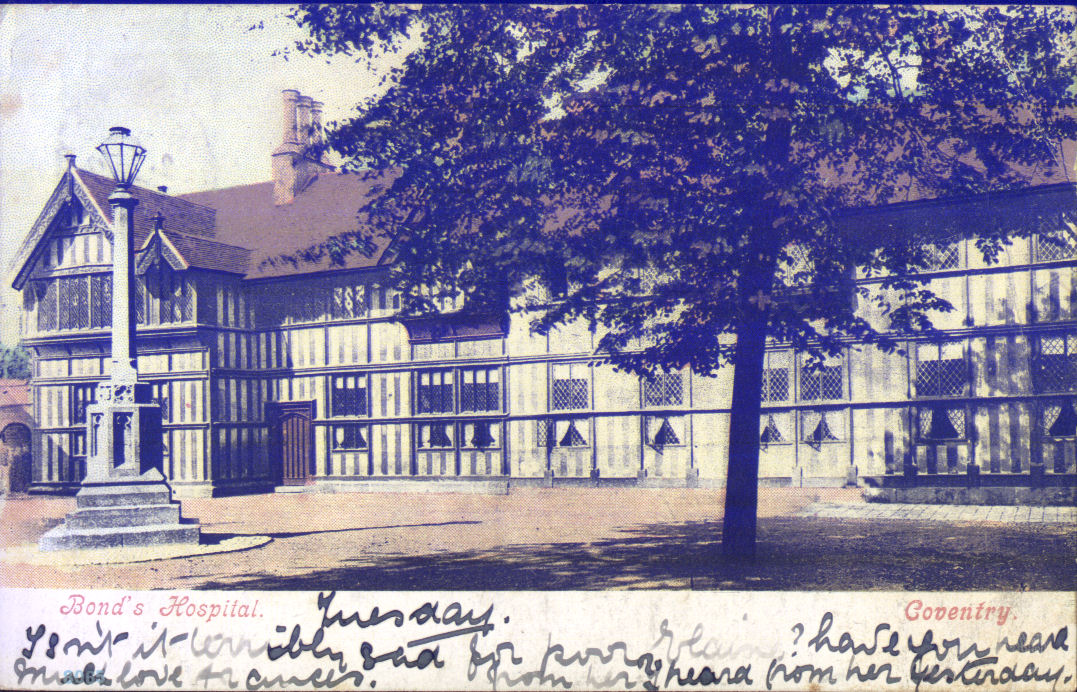
Bond's Hospital was founded in 1506 by Thomas Bond behind St. John's Church. This card was posted around 1905 and the message says "Tuesday. Isn't it terribly sad for poor Elaine? Have you heard from her? I heard from her yesterday, much love Frances." These were the emails of the day. At least our messages won't hang around for 110 years causing us all to anxiously wonder what on earth happened to poor Elaine. The building still stands, looks very much the same and still has a caring use.
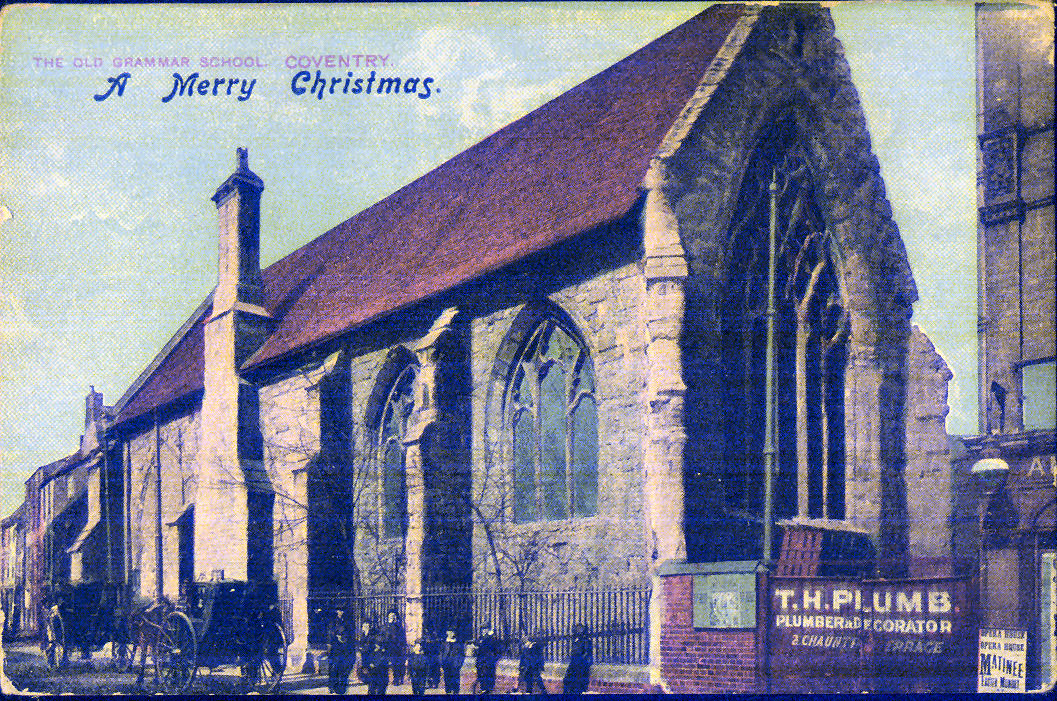
The building now known as the Old Grammar School was, indeed, the building housing the King Henry VIII grammar school from its foundation in 1450 until the present school was built around 1885. The building started life as the Hospital of St. John. It served well until Henry VIII ordered it destroyed and sent one of his toadies, John Hales to do the dirty work. John Hales acquired the Whitefirars Monastery as a home and the Hospital on condition he formed a school in the name of his boss. Henry VIII is the only school in the Kingdom to bear the tyrant's name. The building has become decayed and neglected but is currently undergoing regeneration as part of the nearby Coventry Motor Museum. The School, despite its dodgy origins, is a very good one.

This is the school of Henry VIII at the top of the hill in Warwick Road.
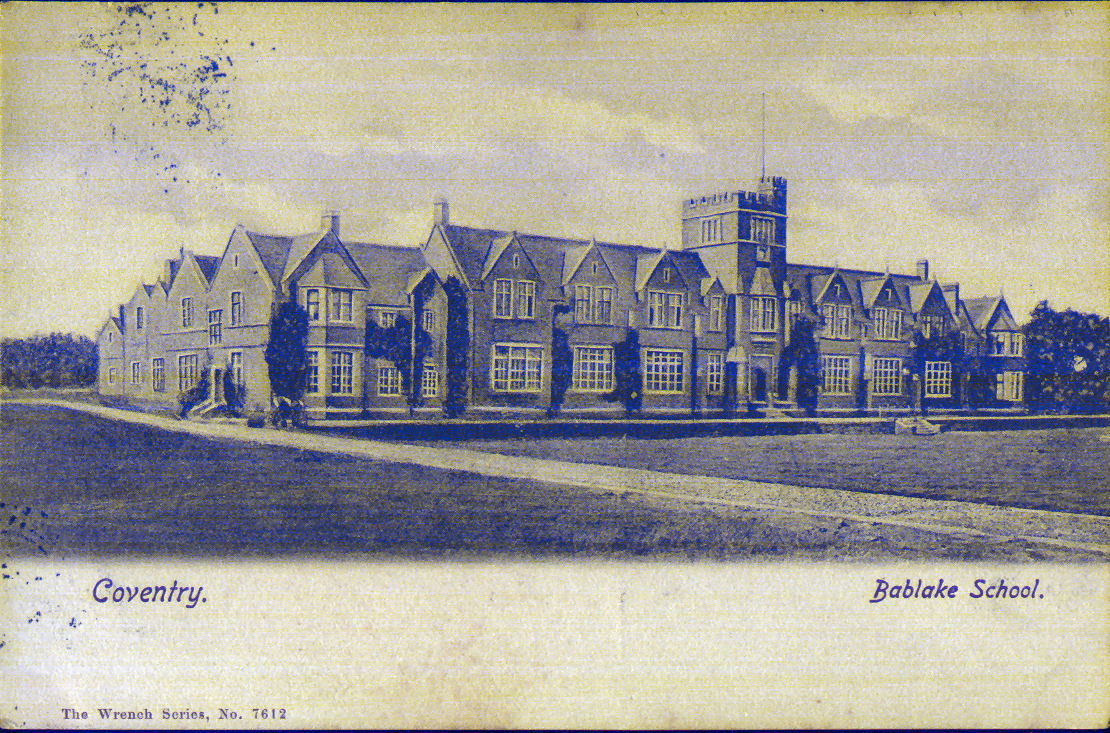
This is the other Coventry Grammar School. The original Bablake School was founded by Thomas Wheatley around 1563 at the bottom of Hill Street behind St. John's Church and moved to the top of the road in 1890. The name Bablake is a corruption of Babu Lacu.
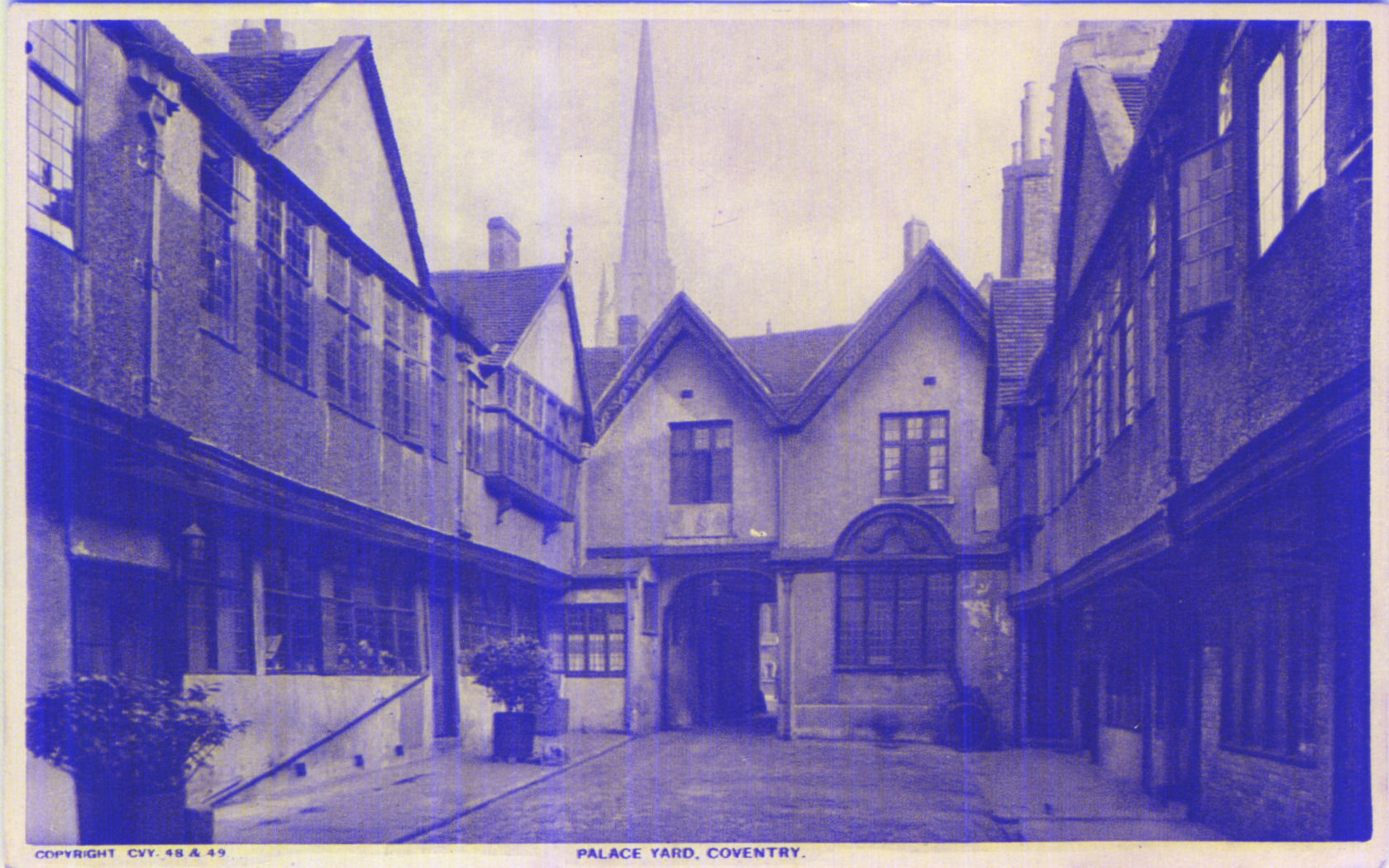
The Palace Yard was a large house in Earl Street, opposite what is now the Council house. It acted as a place of safety for Princess Elizabeth in 1605 and was owned by Richard Hopkins who was a Member of Parliament. It was a fine house for many years and later housed many local institutions. large parts of it burned during the blitz and the remainder was demolished to build civic offices. An area still known as Palace Yard exists within these office buildings but has been neglected and become a horrible place.

The Kings head hotel was probably the finest hotel we ever had in the centre of Coventry. It disappeared on the night of the November blitz. The statue of Peeping Tom shown previously graced the fourth story corner. The Statue was later housed in the newly built Hotel Leofric for many years and is now near the top of Hertford Street.
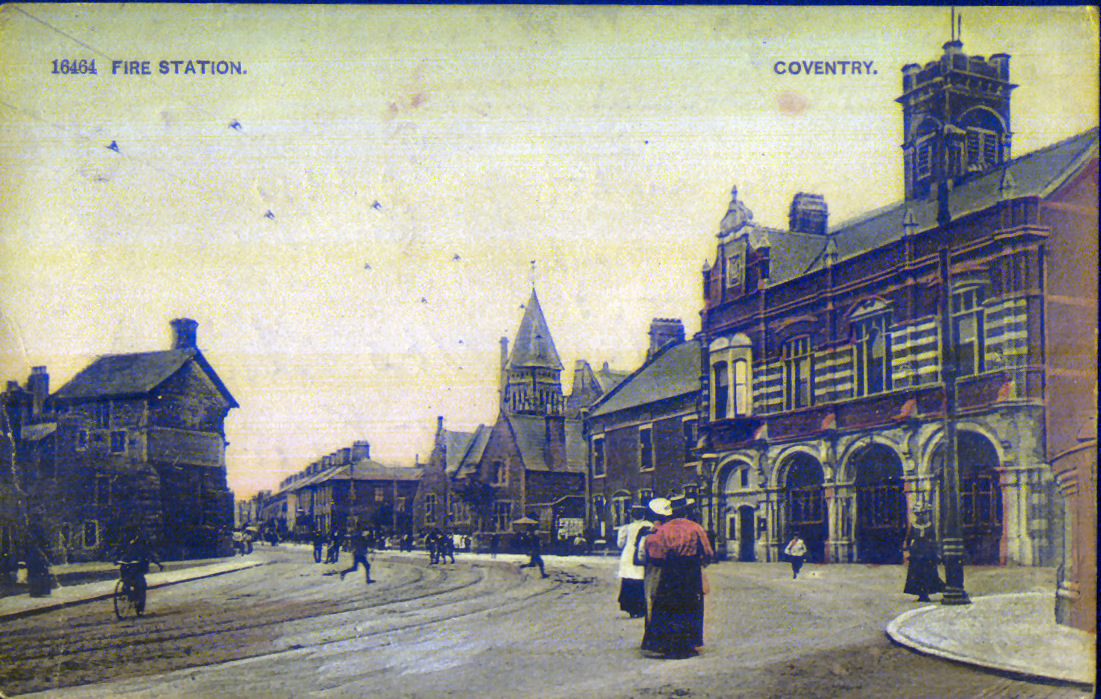
The Fire Station was built in 1912 but had only four bays. The present building has six. I suspect the houses next door were too expensive to buy immediately and possibly housed the fire officers. A row of houses for firemen was built opposite in Chauntry Place. The Fire ladders then left Broadgate.

Coventry Station was built by the Midland Railway in 1848 and, had it survived, would probably be listed. The present station is listed.
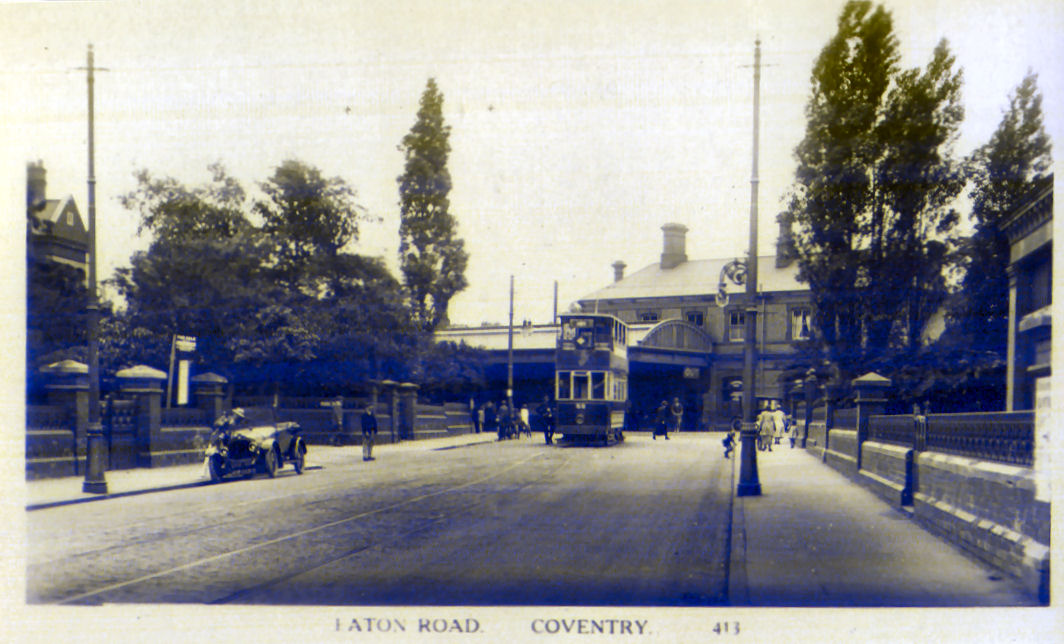
Note the fine Victorian lamp post and tram lines. The tram is clearly an electric version and was at the terminus of the first Coventry tramline that ran to Bedworth. One has to admire the bravery of the ladies in their crinolines on that exposed top deck.
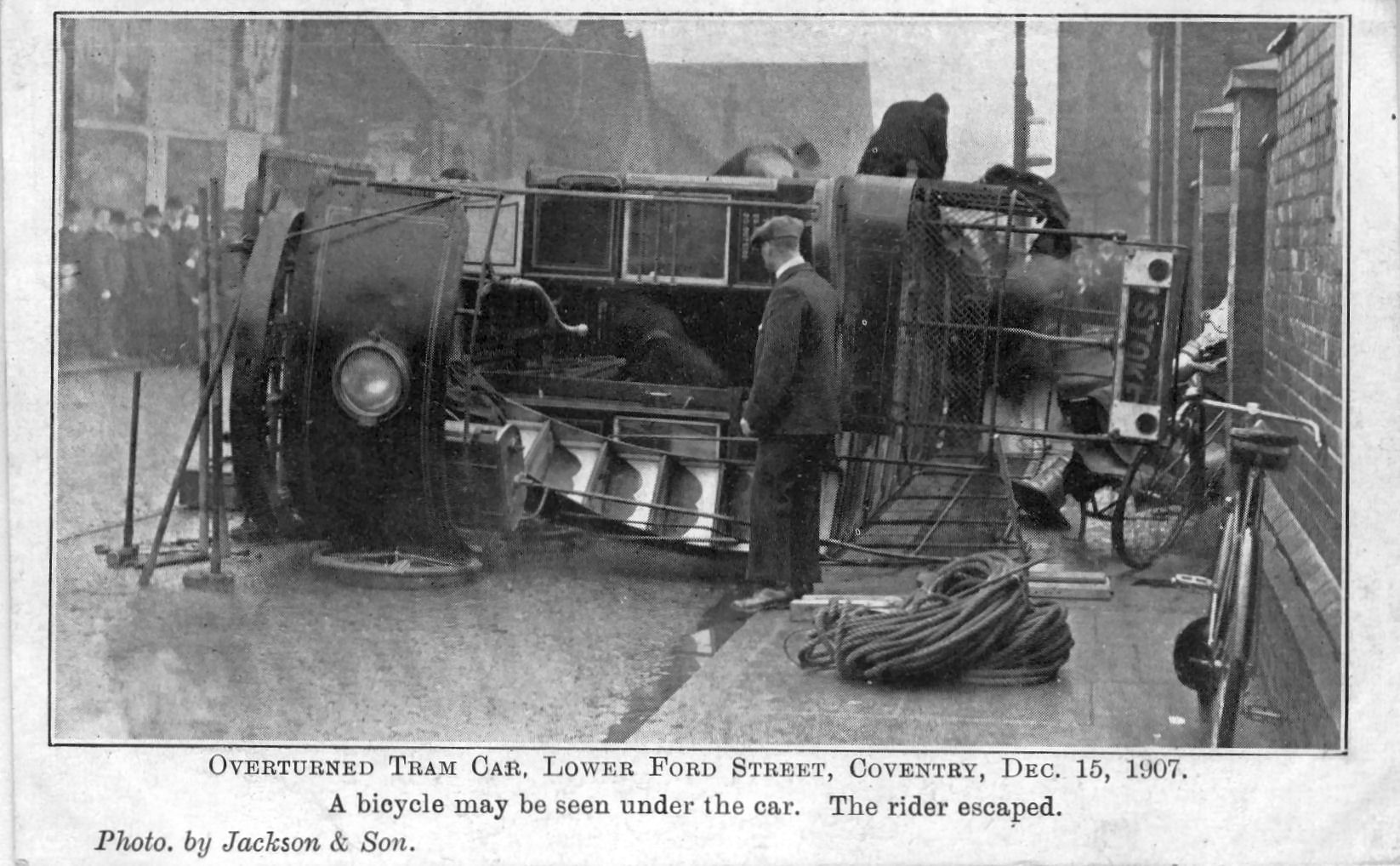
It is to be hoped the two ladies above were not on this tram.
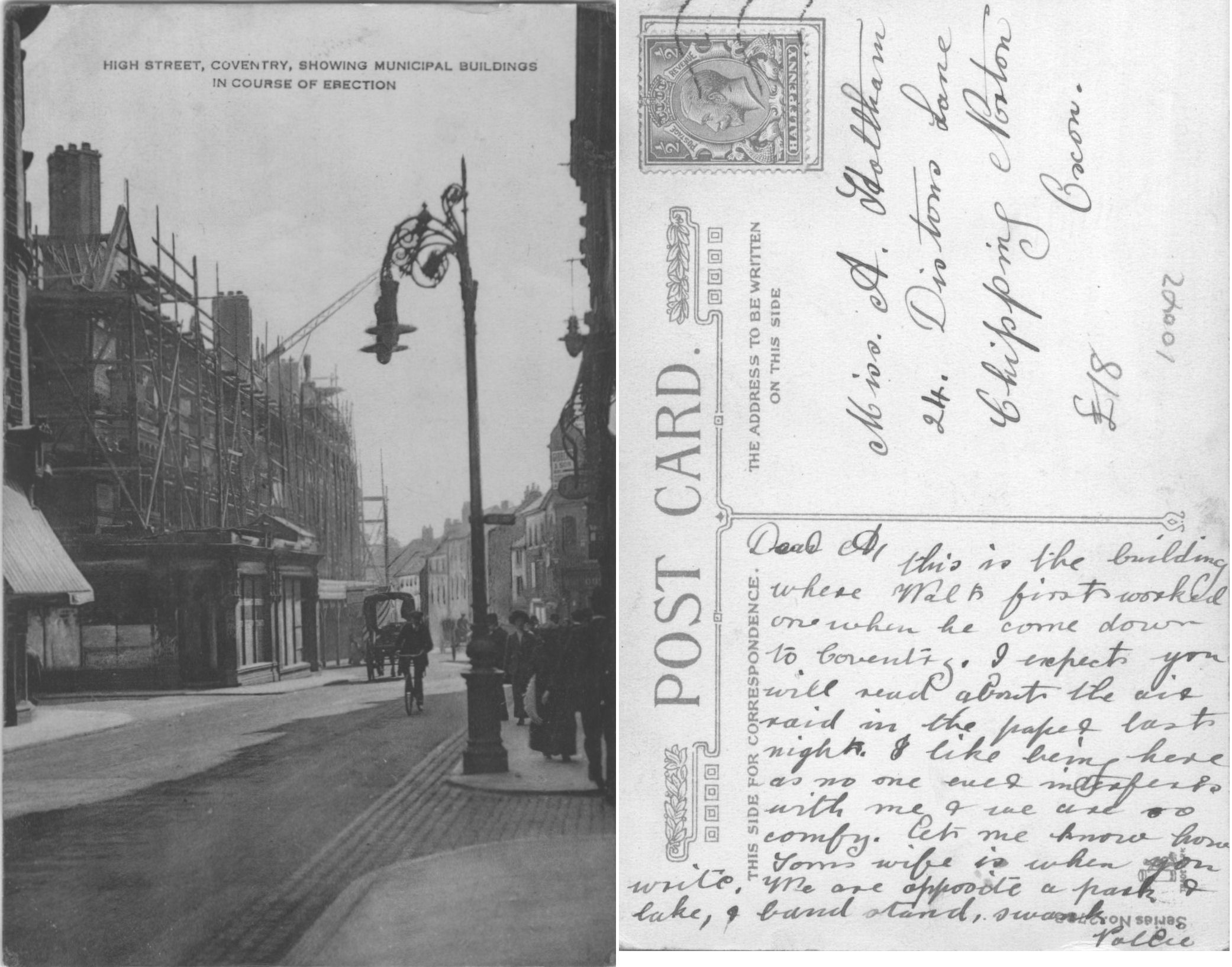
The new Council House was started in 1914 and , amazingly, work continued through the war. It was opened in 1919. This card has a lovely message which gives several insights into the life of the sender. The address in Chipping Norton can still be seen on Google Maps.
Dear Di, This is the building where Walter first worked on when he came down to Coventry. I expect you will read about the air raid in the paper last night. I like being here as no one ever interferes with me and we are so comfy. Let me know how Toms wife is when you write. We are opposite a park & lake, & band stand, Swank. Pollie
The description almost certainly shows that Pollie and Walter lived in the cottages now in Middleborough Road opposite Naul's Mill Park. The Air Raid was a Zeppelin raid which only came to Coventry twice. One raid was in 1916 and the other on 12 April 1918. Unfortunately there is no date on the postmark.
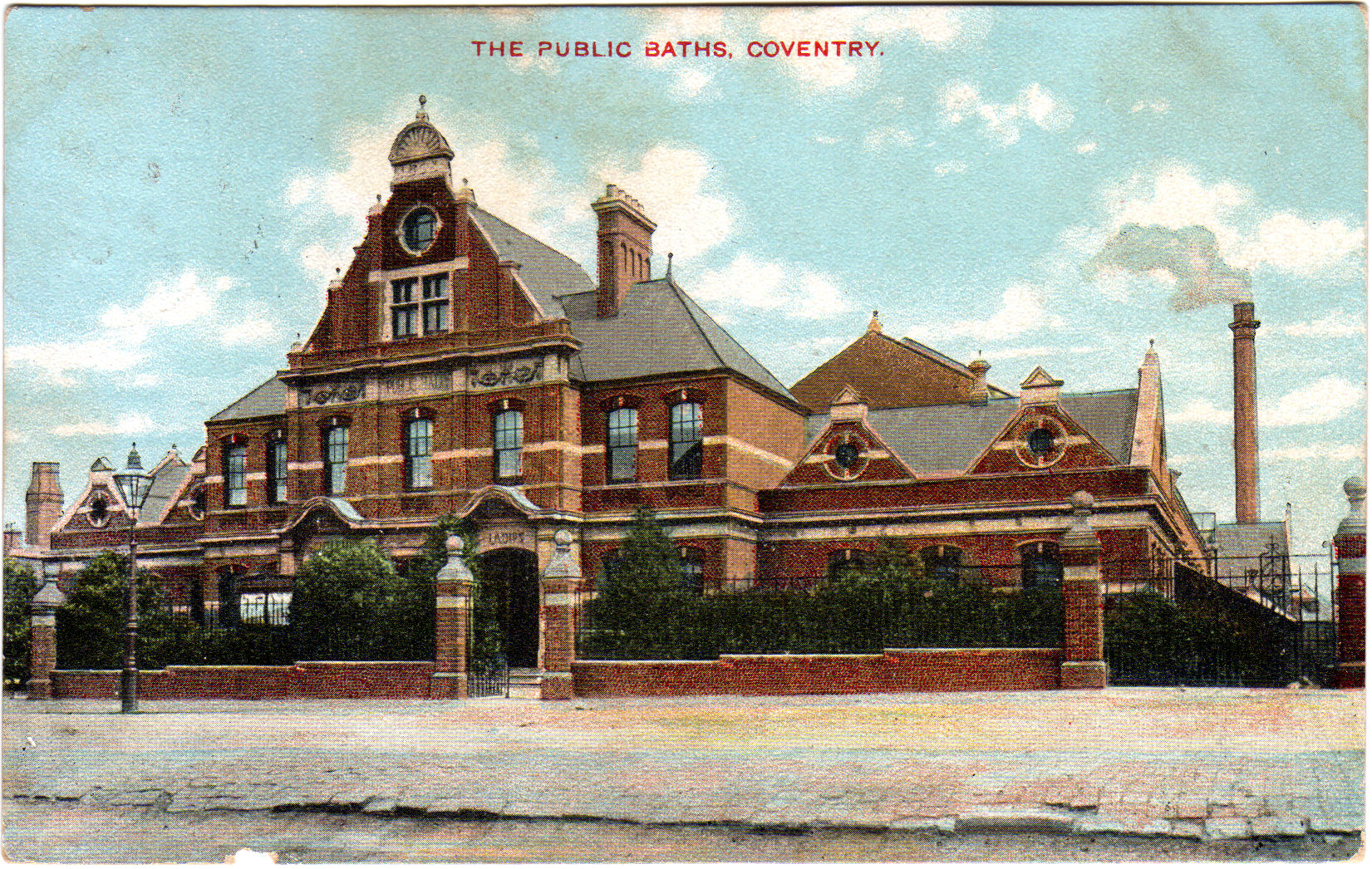
The new public baths were built in 1898 in Priory Street. The facilities included swimming baths and first and second class private baths. At that time virtually no houses had bathrooms so the public baths were well used. They also included laundry facilities.
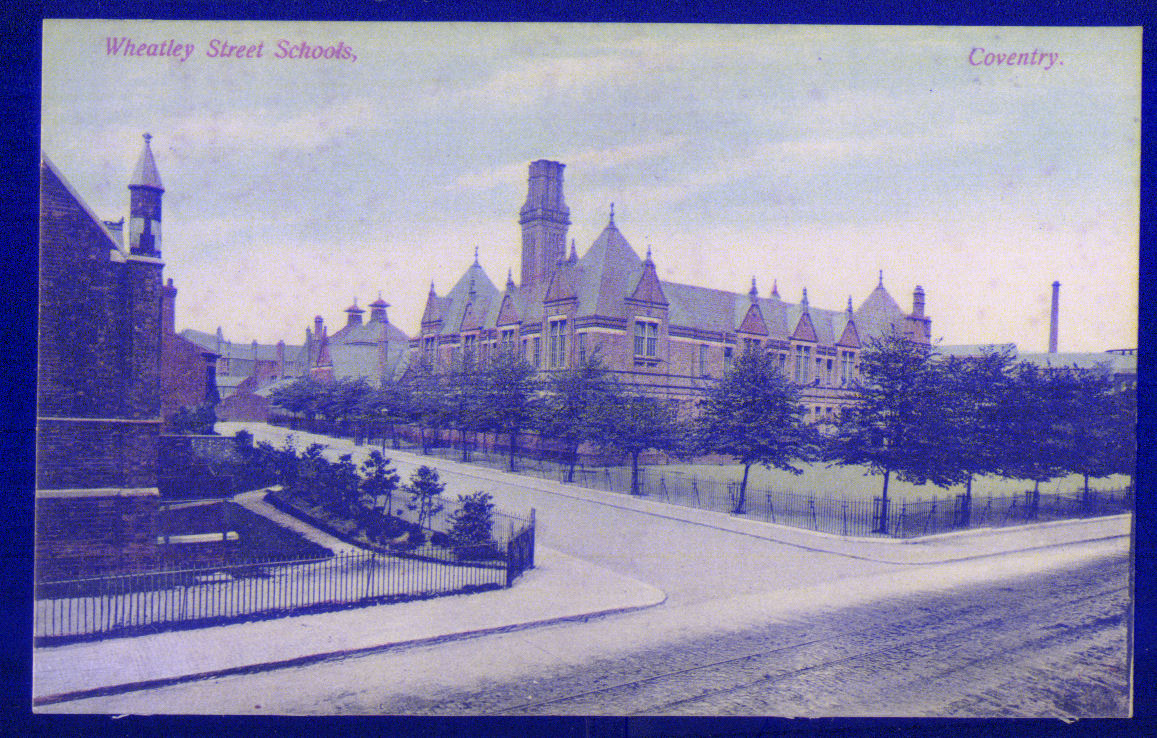
The Wheatley Street School was built in 1893 for 1228 pupils. The street in the foreground is Ford Street. I went to this school for night classes as an outreach of The Technical College as late as 1958.
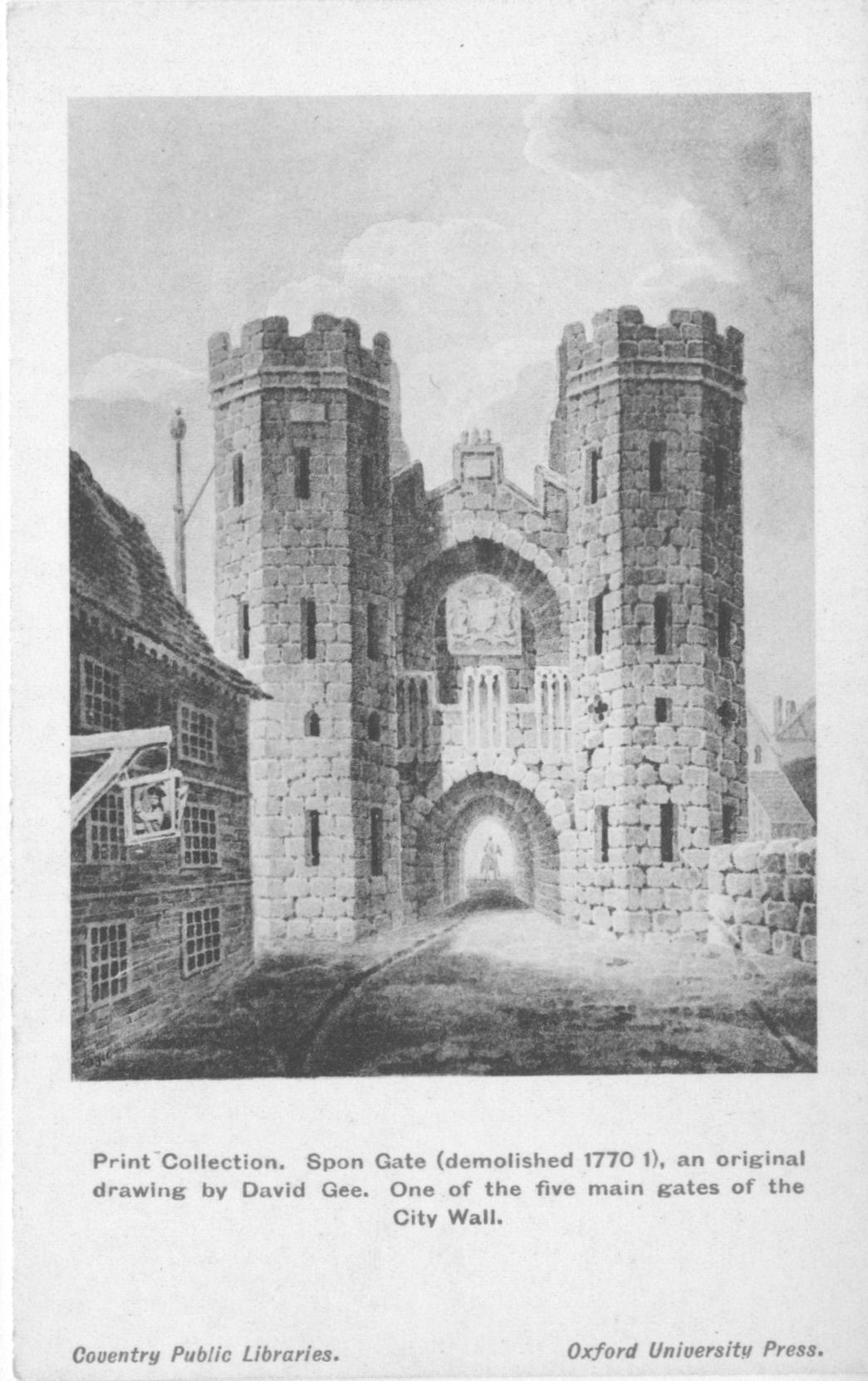
The Spon Gate of the city wall survived until around 1776 when most of the gates were demolished to allow larger carts to enter the city. The stone from Spon Gate was taken a mile up the street to build a new bridge over the River Sherbourne. Part of the city wall can still be seen in the houses next to St. John's Church. Other parts are also visible, notably in Lady Herbert's Garden.
In the Civil War a cannon was moved from Kenilworth to the Spon Gate and Coventry was never attacked despite being a major player in that war.
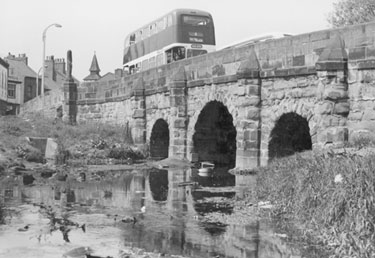
This is the Spon End bridge across the River Sherbourne built with stones from the Spon Gate around 1777. It still carries traffic and has stood the test of time.
Parks in Coventry

Views of The Swanswell were third in popularity after Godiva and the Three Spires from Greyfriars Green. The Coventry and North Warwickshire Hospital survived and operated until around 2006. The Swanswell is the last remaining part of Babu Lac.
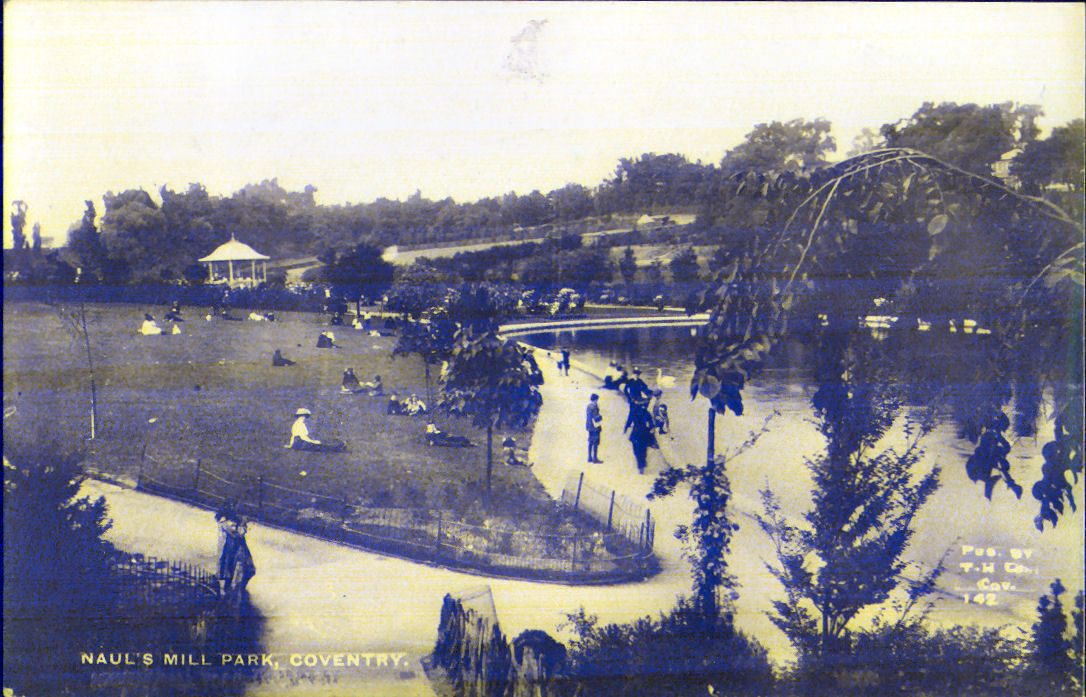
Naul's Mill park was built around 1910 by Coventry City Council. The band concerts on a Sunday afternoon were so popular that local wits claimed the crowds leaving to go into town had to walk three high in Mill Street.
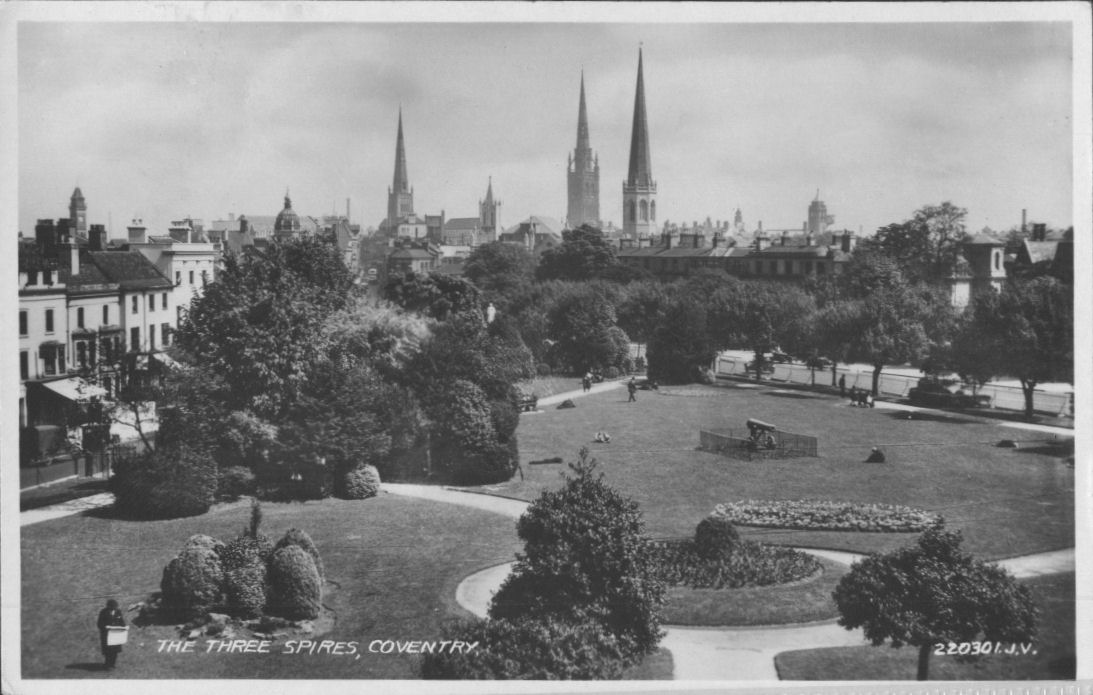
This was the second most popular card and shows the three spires in their classical formation. Such a vantage point is quite rare. The park is still lovely although there have been many changes and some diminution of its size. In the centre can be seen a cannon which came from the Boer War and was given to the city when the Barracks were closed. The tank presented to the city after the Great War was in the bushes on the left until recycled during the Second World War. The houses on the left were where George Elliot (Mary Ann Evans) worked for several years.
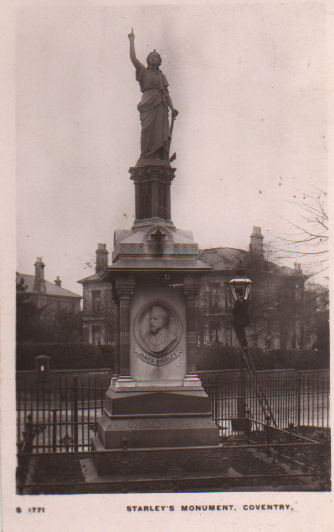
Slightly further out of town in the picture above is a statue of James Starley. He no longer has his triumphant arm. I once heard a lady complaining about the lack of an arm. I kept quiet but was tempted to point out that the most famous statue on earth has no arms. James is credited with designing the first differential gear for a tricycle. The principle had been known and used before but he was quite possibly the first to apply it to modern transport. There is probably not a single vehicle on earth with four or more wheels that does not have a differential - other than, possibly, electric vehicles. It was a major and almost ubiquitous advance in automobile engineering and invented in Coventry.
.jpg)
Top Green on Warwick Road has hardly changed in one hundred years but is not quite as well kept as this photograph shows. This was for much of the late nineteenth and early twentieth century the top of the "Bunny Run". This started in Broadgate and was where the young working people went to meet others of the opposite sex.
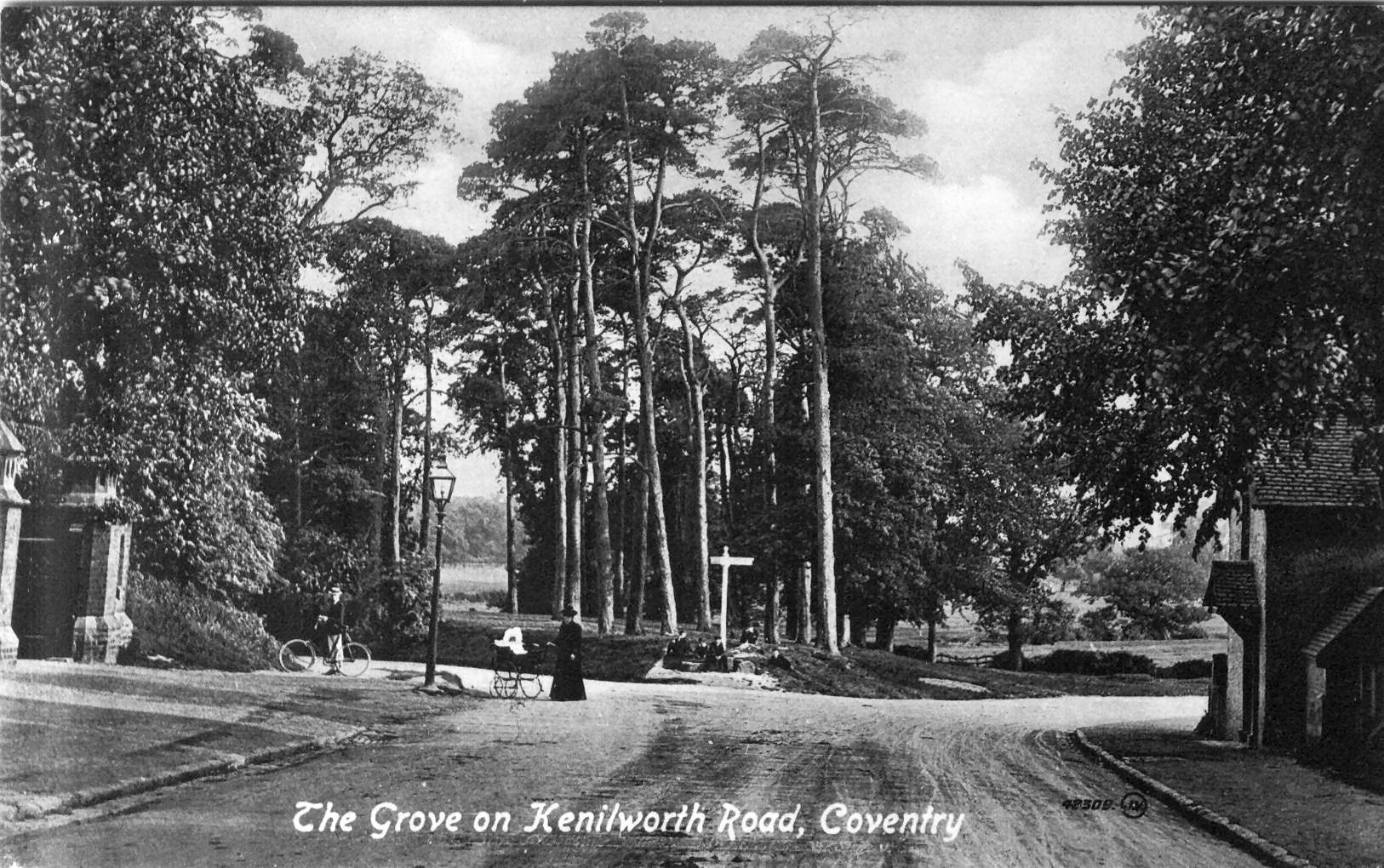
The Grove is adjacent to Top Green at the diversion of the Kenilworth Road from Warwick Road. On the right is a Toll House, now long gone, but the grove remains substantially the same. Some of the trees there are claimed to be quite ancient.

Alfred Herbert was Coventry's single most successful industrialist and dedicated this garden to his wife. It was built around 1936 as a public park with private Almshouses at the rear. These, together with Bond's Hospital and GreyFriars Hospital now form a charitable institution.
Swanswell Gate or the Prior's Gate is part of the city wall that runs through the garden and terminates at Cook Street Gate.

Cook Street Gate
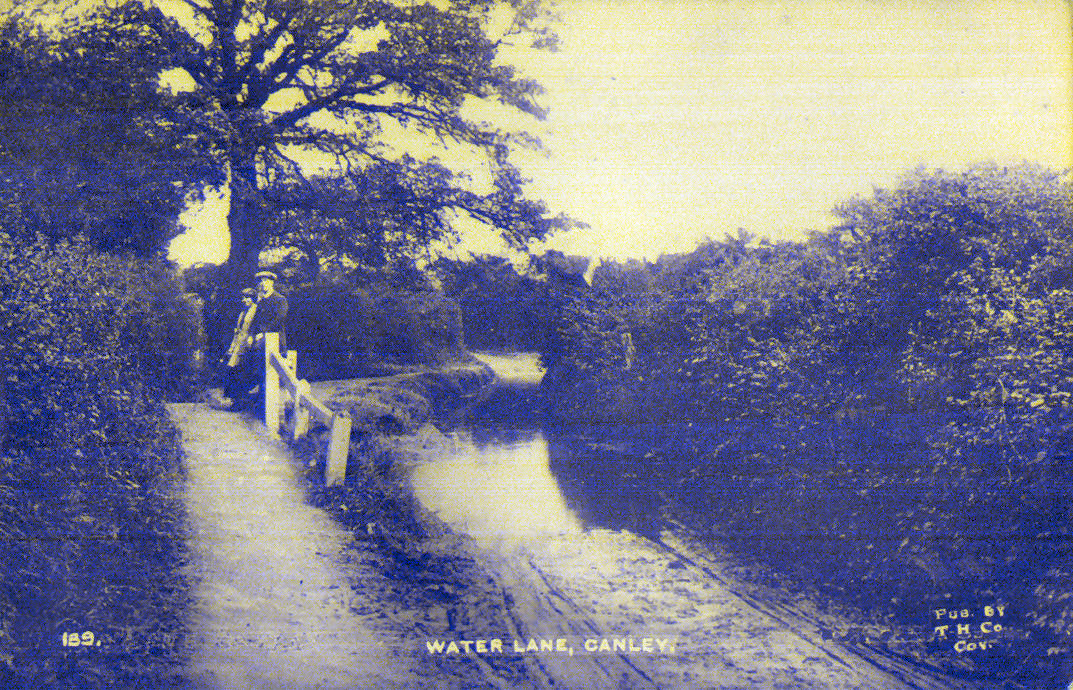
Water lane in Canley was a popular postcard. It shows a ford formed by Canley Brook. The road has been closed to vehicle traffic since the 1970's and the immediate area is in the care of a trust and still looks very good but has several more trees surrounding it.
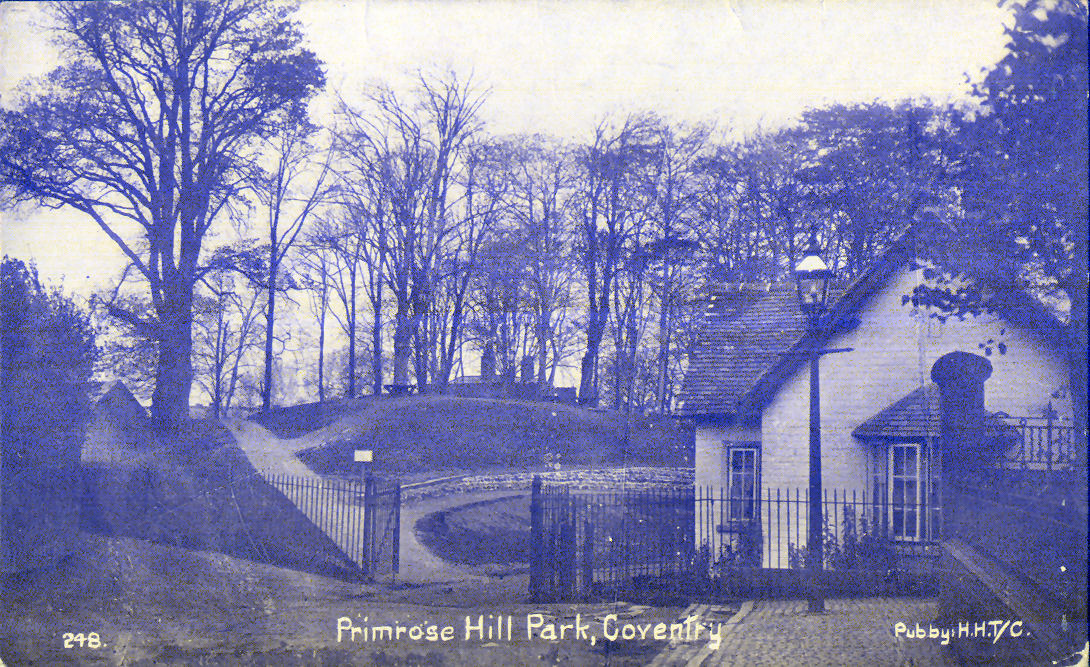
Primrose hill Park is in an area of the city that has aged and been substantially regenerated but the park is much the same now.

The Kenilworth Road was an endless source of photographs for cards. This is claimed to be the best entrance to any city in Britain and probably justly so. It was usually called The long Avenue. Despite a huge increase in traffic it is still a pleasant road.
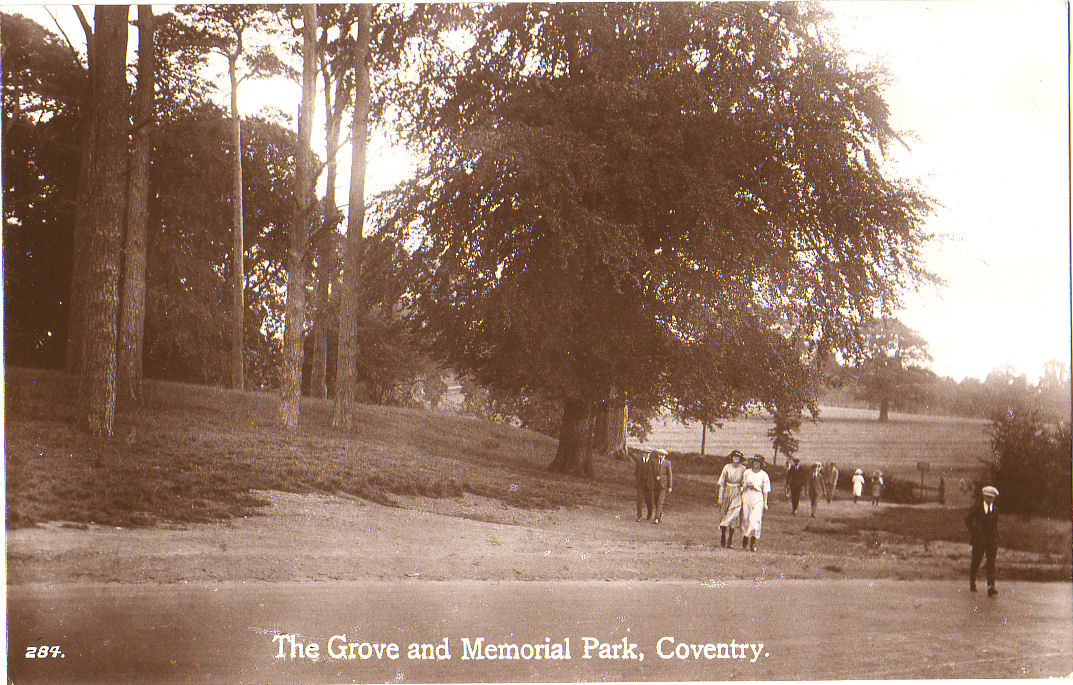
At the other end of the Kenilworth Road was built The memorial Park which was opened in July 1921 as a tribute to the 2587 dead the First World War. A temporary memorial was built on Spencer Park from1919 until 1927 when the cenotaph in the Memorial park was built.
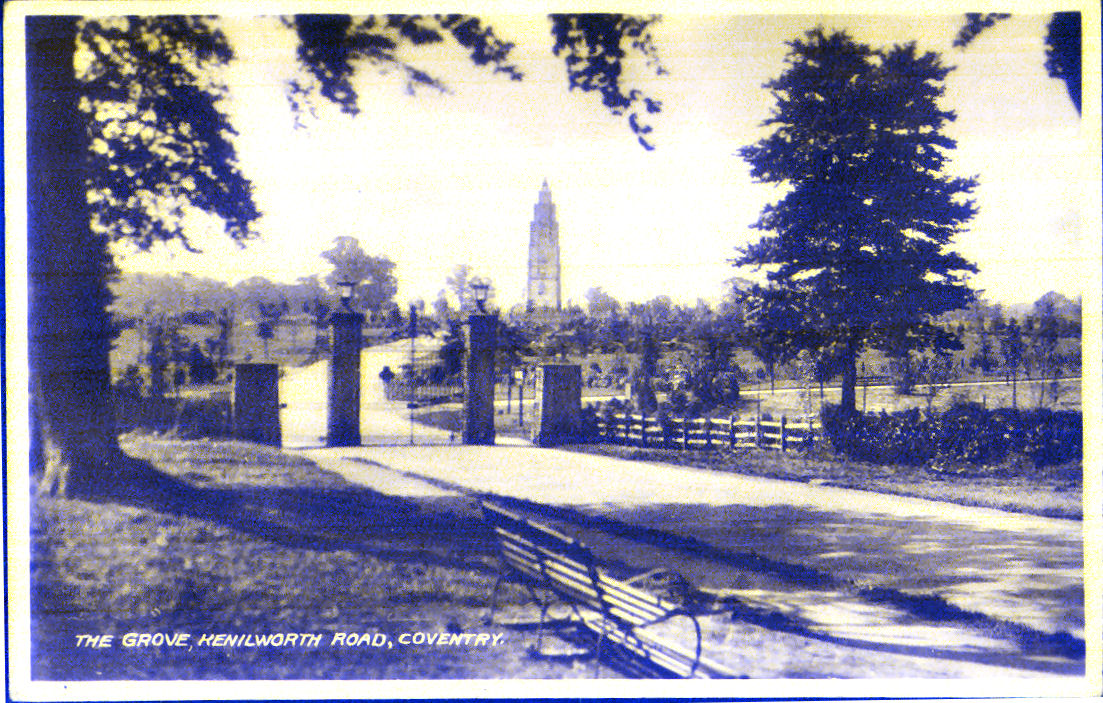
This shows the entrance much as it remains today.
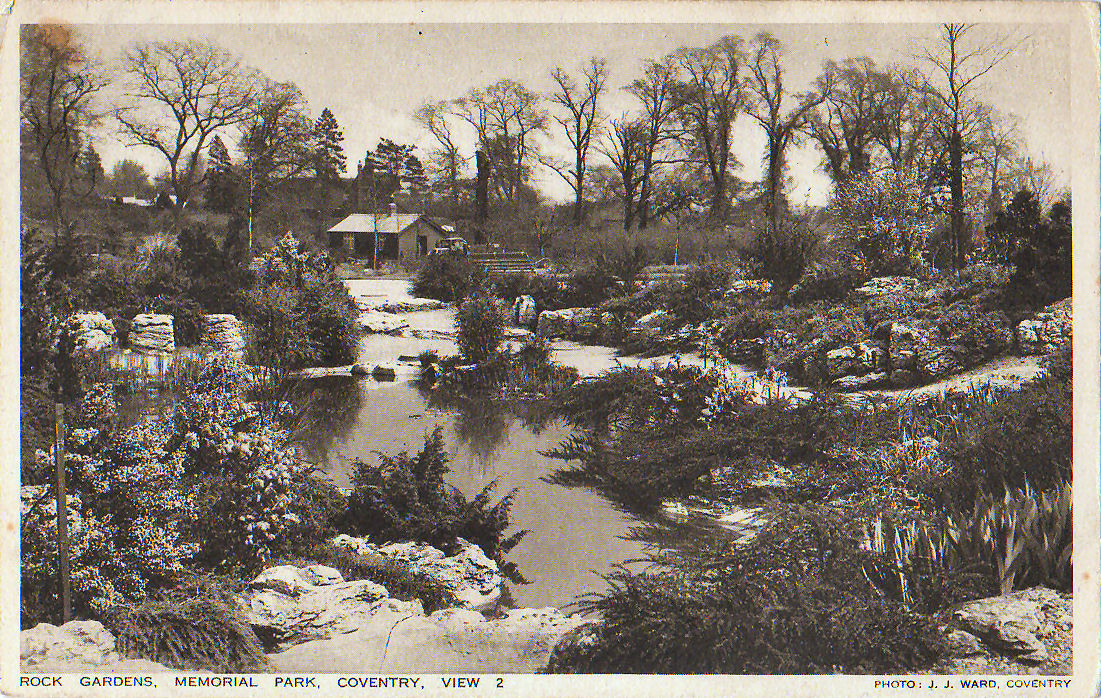
The Rock Garden was a particularly pretty part of the design and was well loved by several generations of children. Sadly it was allowed to decline. A substantial grant has recently been spent on restoring and maintaining the park but nothing has been done with this once-lovely garden.
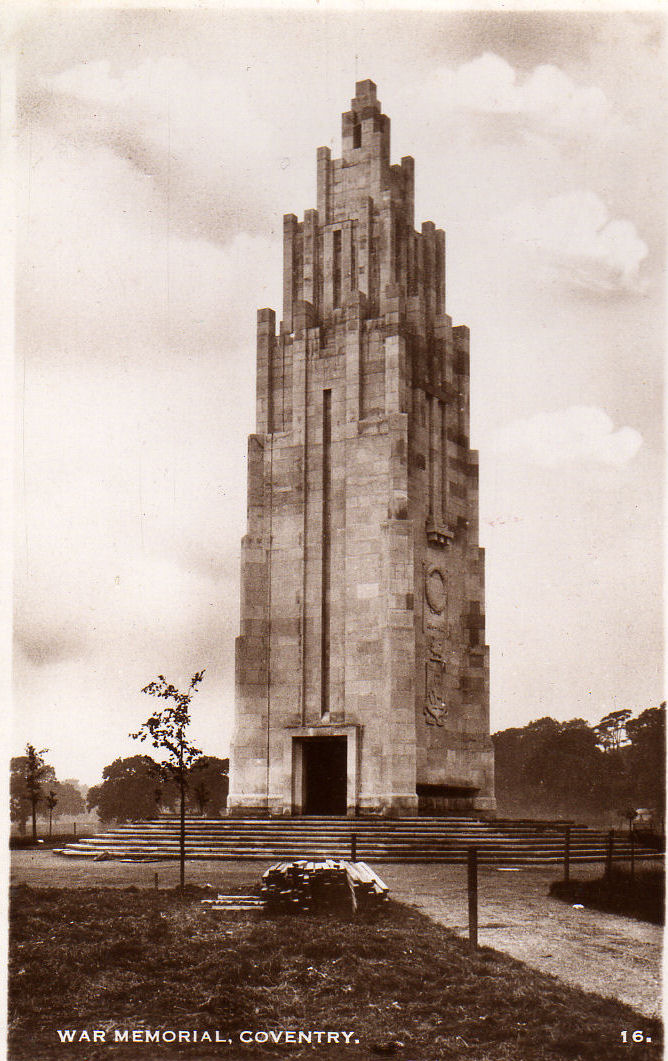
This shows the memorial when new. It remains the same except for access ramps on the steps and the trees have long since grown to maturity. The memorial is now also dedicated to the dead of the Second World War and there are monuments to other conflicts. There is a Remembrance Service there at 11:00 am on the nearest Sunday to the 11th November every year. The service is very well attended. Their sacrifice has not been forgotten.
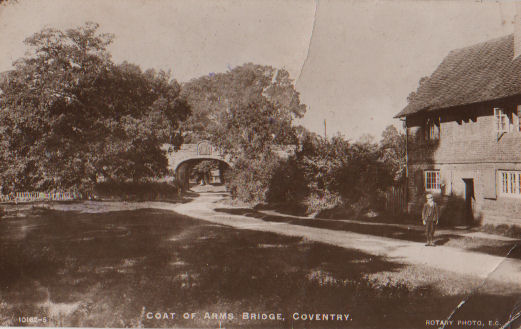
Behind The Memorial Park is Coat of Arms Bridge Road. The railway goes from Coventry To Kenilworth and was built in 1842 on land owned by The Gregory family. The bridge bears their family crest. The family had links to the Gregory-Hoods who were linked to Whitley Abbey and were the family that gave their name to the famous battleship Hood.
Streets of Coventry

This is Butcher Row and it was one of the finest medieval street scenes in Britain. Up until 1936 Coventry had more medieval buildings than any city in the land. Had it survived and been given some tlc it would have made York look quite sick. It was demolished in 1926 together with several adjacent streets to build a bus stop.
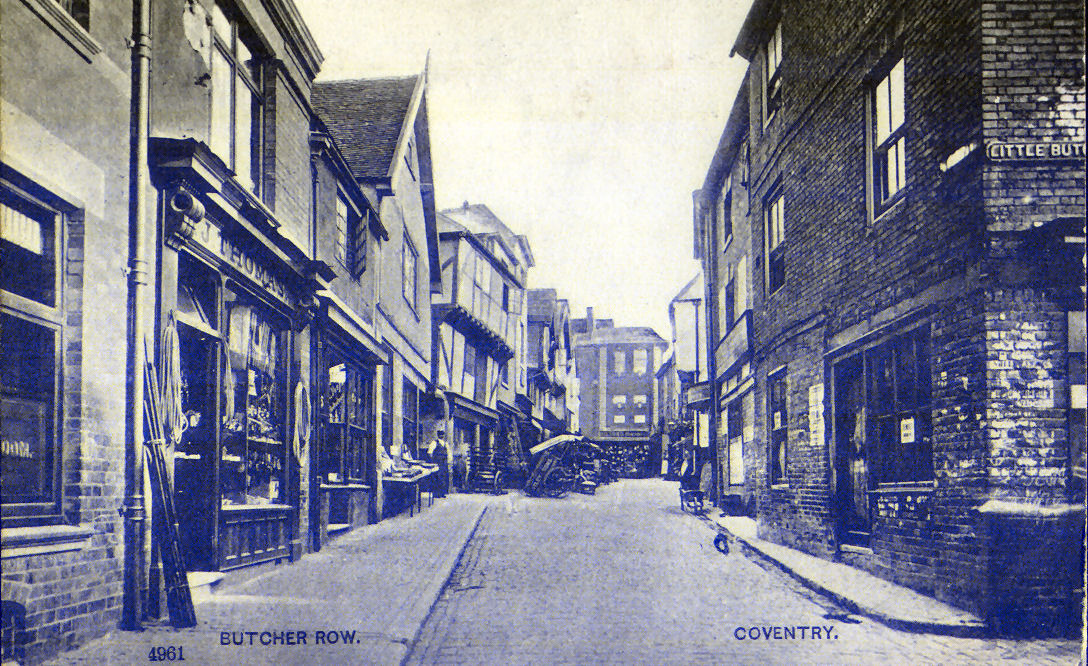
This view looking in the other direction also shows the corner of Little Butcher Row
.jpg)
The loss of these gems was a major disaster but there was much more interest in the fragile recovery from the Great Depression and the looming reality of a Nazi takeover of Europe.

Trinity Lane was hard up against the front of Holy Trinity Church and was the back alley to the houses in Butcher Row.
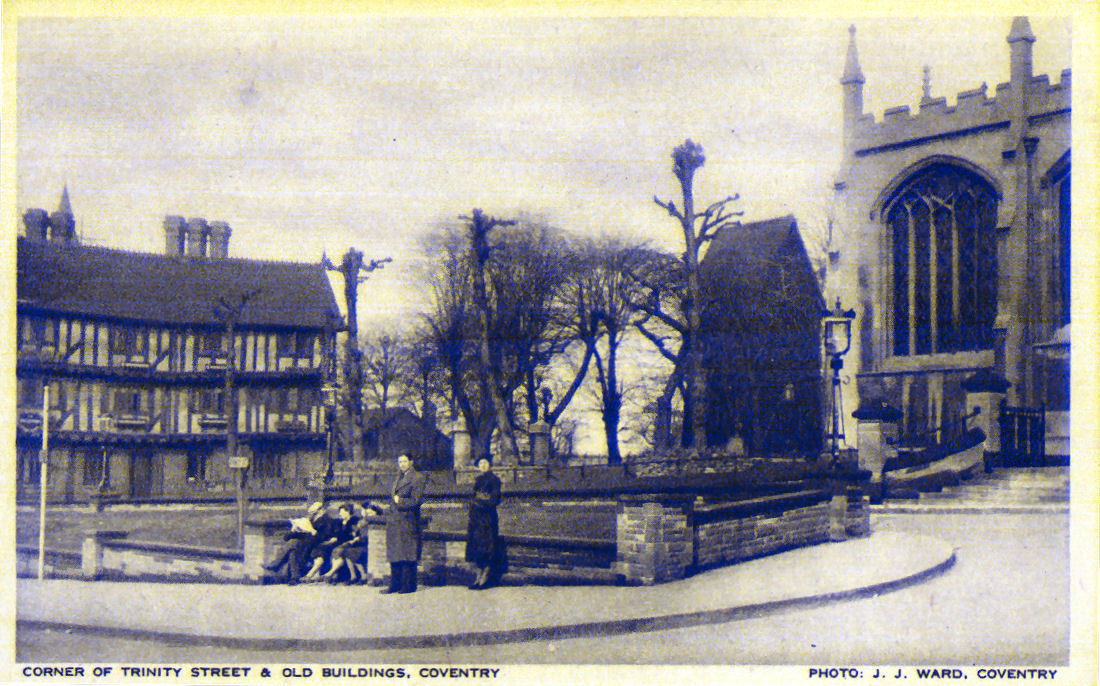
This is still, in essence, the scene today of the site where Butcher Row once stood. This photograph was probably taken around 1939. Note the campanile for Holy Trinity church.
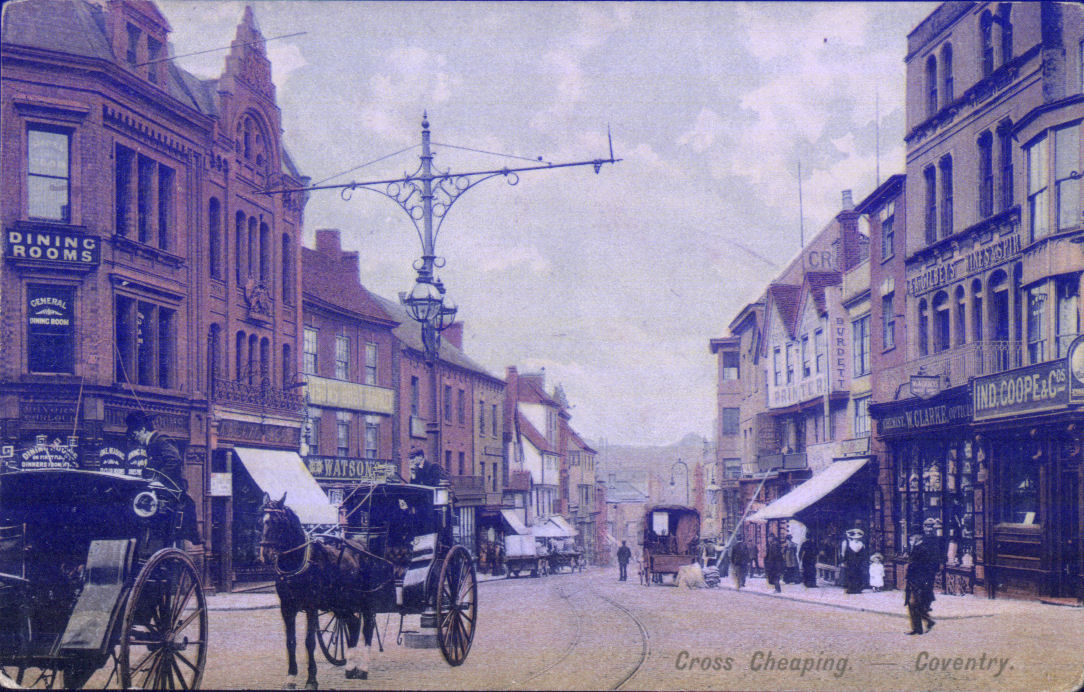
Cross Cheaping led down from Broadgate to The Burgess. Cheaping is a derivation of an old word meaning trade and this road had its share of active and prosperous looking shops.
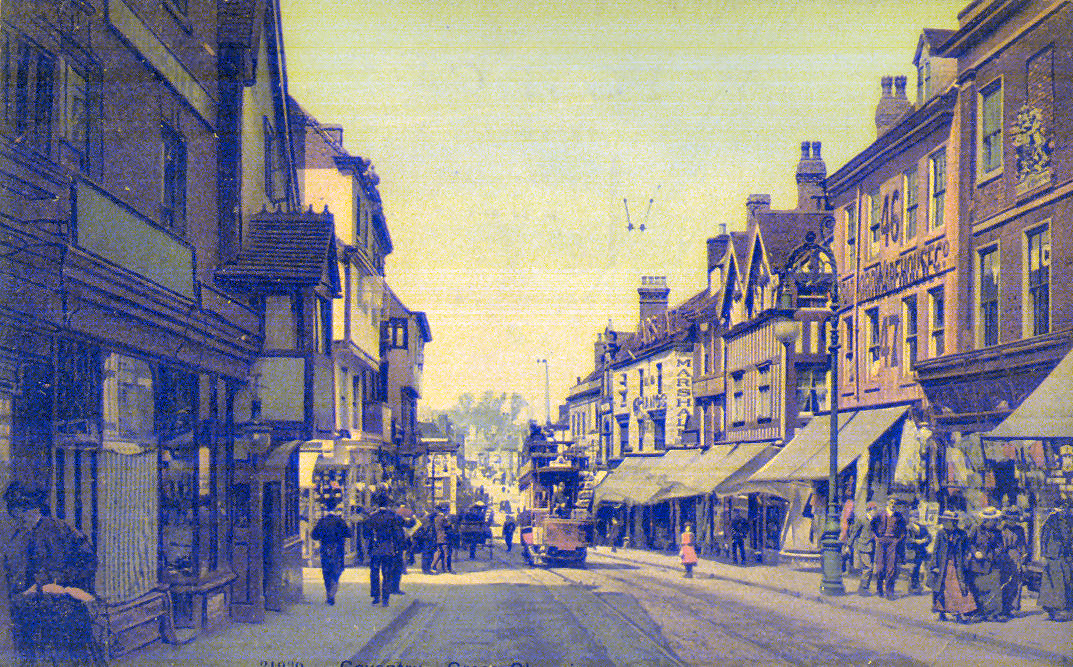
The Burges - a corruption of The Bridges - followed an ancient route to Barrs Hill and this section led down to Bishop Street and contained two bridges over the River Sherbourne and the Radford Brook. The road on the left was West Orchard which had once gone through the Bishop's orchard to Smithford Street. The entrance to West Orchards is now in the same place. To the right just out of sight was Little Butcher Row.

Back in Broadgate the entrance to High Street shows Coventry was booming in the late 1930's. The government had built shadow factories around the city and they were fully geared up for war production despite constant pleas that Britain was ill prepared for the second world war. The two policemen on point duty certainly look as though they have their work cut out.
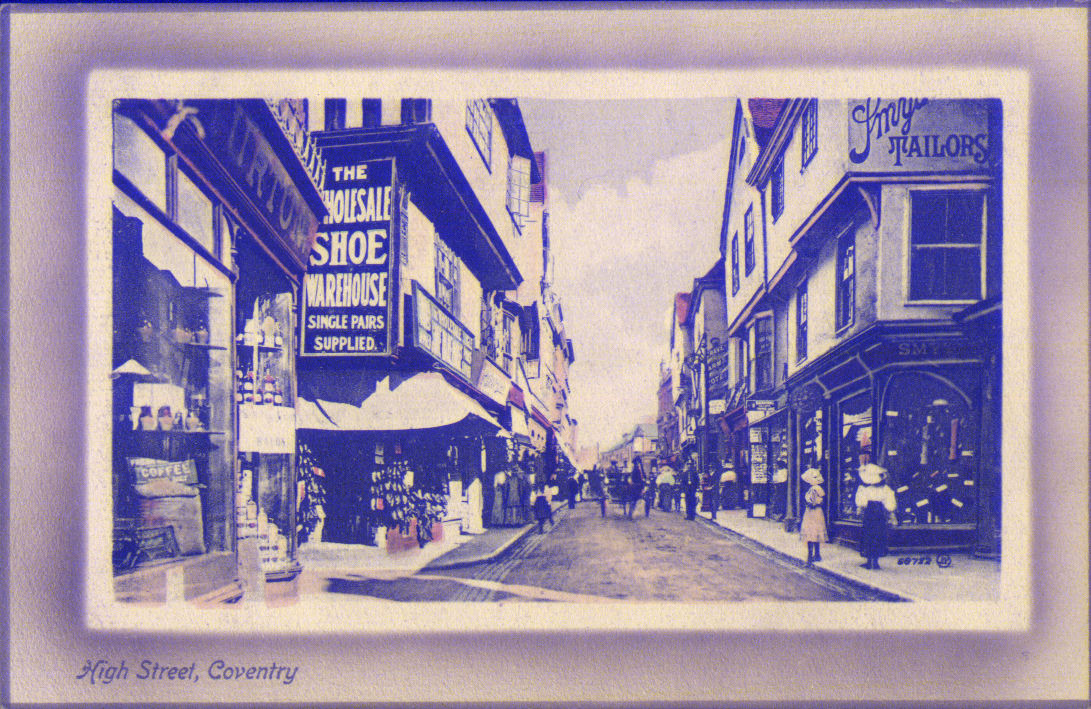
This classic view of High Street shows the medieval character of the city well. On the left is Pepper Lane and to the right is Greyfriars Lane. The street retains a similar view but all the frontages have gone and little of the medieval fabric remains. The street is now double the width.

This photo was taken outside St. John's Church and is looking up Smithford Street - now the Lower Precinct. Nothing in this scene now remains.

Hertford Street had been built on part of The Barracks in early Victorian times to relieve the bottleneck of Greyfriars Lane. It was a well laid out streetscape. Much of it remains but it has been ruined by putting a tunnel underneath it to access The Barracks car park and thereby necessitated steps and a ramp which utterly spoils the lines of the street. Good taste in architecture has been largely absent since around 1960.
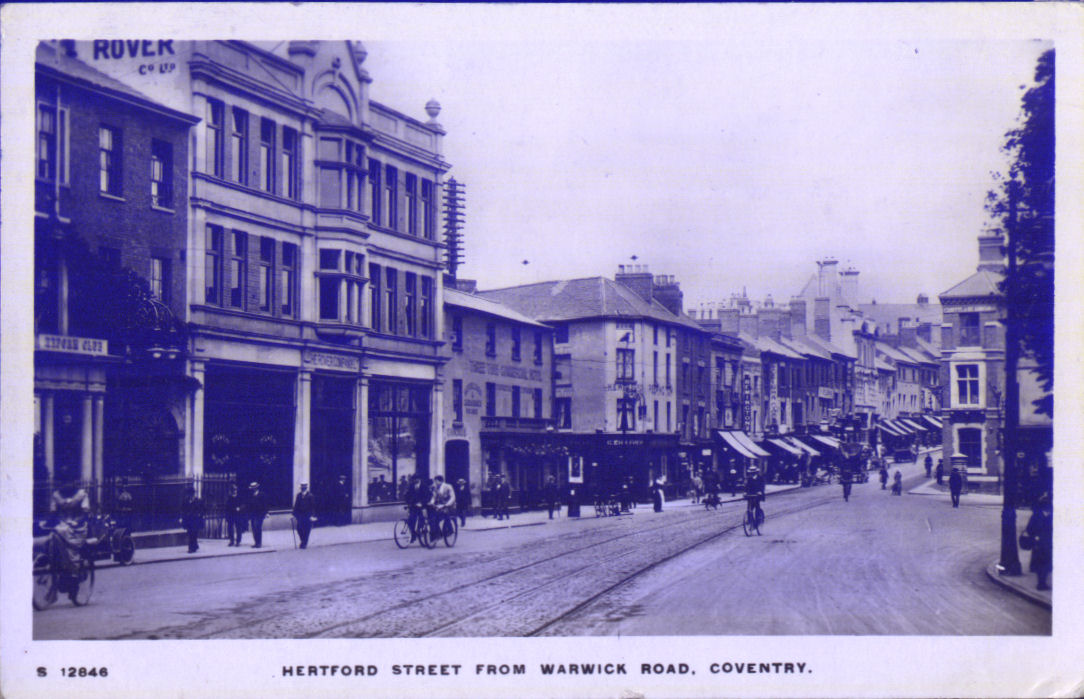
This view of Hertford Street shows the newly built offices of The Rover Company. The factory covered much of the old Barracks and stretched back to Queen Victoria Road. The company moved to Red Lane at one stage and then to Lode Lane in Solihull. The building was known between 1948 and 1960 as The food Office and issued Coupons which were needed for everything from sweets to overcoats. The one good thing about it was it issued free American-supplied Orange Juice and Cod Liver Oil. The latter was yuckky but worth putting up with to get the orange juice which simply did not otherwise exist in Britain between 1940 and 1950. The shop dead centre on the corner of Bull Yard had a small statue of Peeping Tom in the third floor window. The rover building exists but with a pseudo facade.
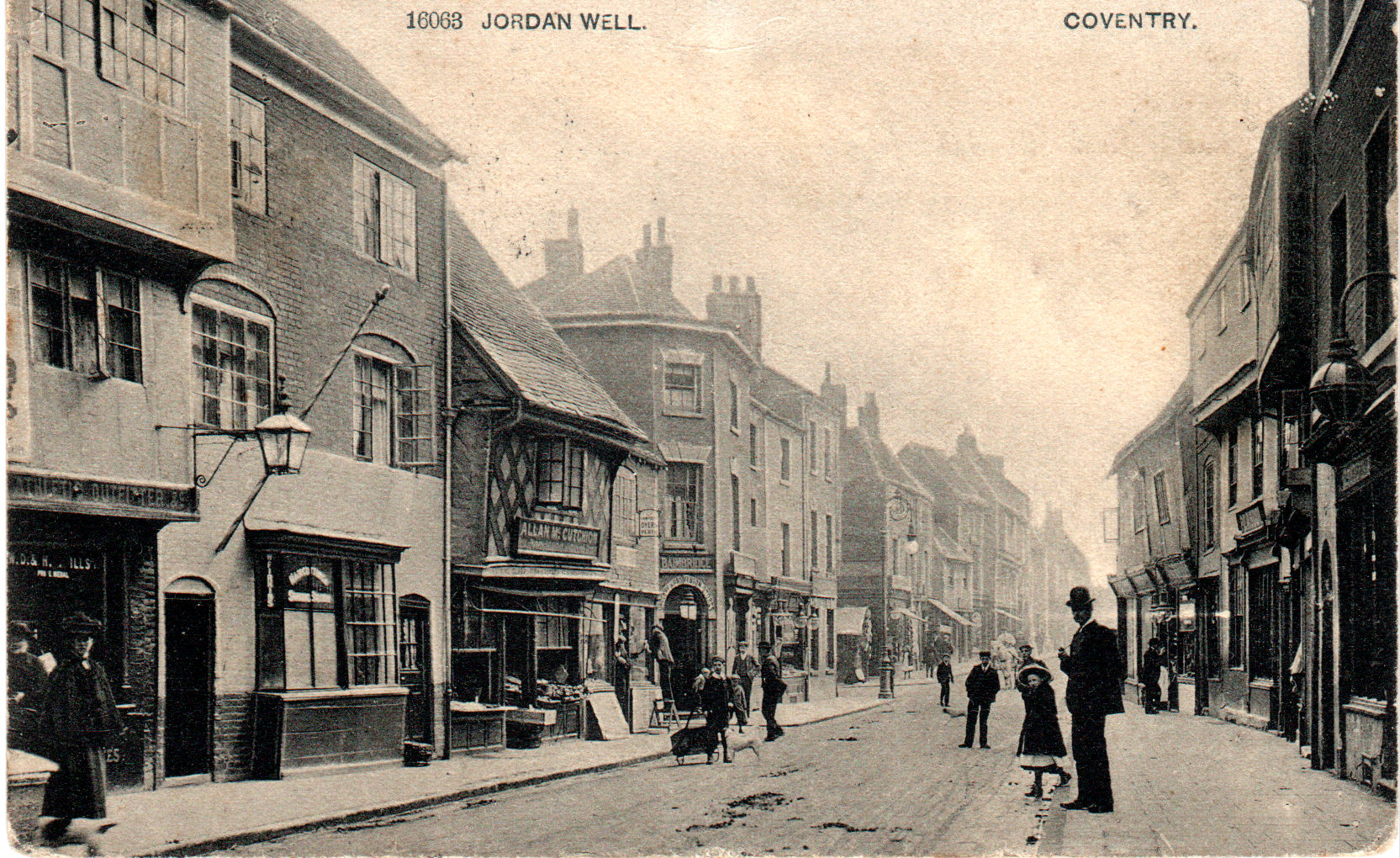
This photograph was probably taken around 1905. Jordan Well runs on exactly the same route today but nothing in this scene remains. On the left is a small street that led to New Street where the Bishop lived and is now under the recently built (2014) university community building. The street had houses so small that a man could shake hands with another in an upstairs window of the house opposite. On the right behind the buildings jutting out was built The Gaumont cinema on the corner of Whitefriars Street. This was later The Odeon and is now the Arts Centre of Coventry University.
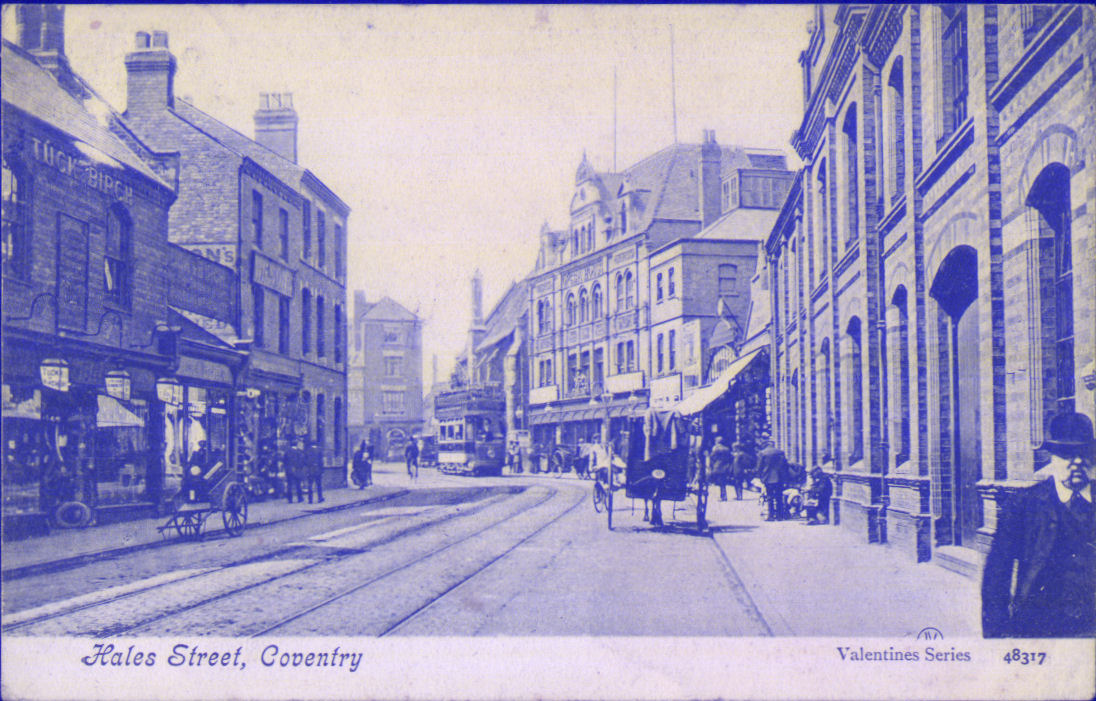
Hales Street presented itself well. The row of houses on the left is largely still there. Back left was a building demolished to build Corporation Street and the Gas Showrooms. On the back right was the Opera House which operated as an opera for about ten years then converted to a Music Hall and later a cinema. it closed around 1960. The building on the right had a plough on top of the plinth top right and was Matterson Huxley & Watson, for long Coventry's biggest ironmonger. It is now the Coventry Motor Museum.

The market hall and Market Square were more or less where the back entrance to West Orchards now is. Only the tower remained after the blitz and that was demolished shortly after.
Coventry Industry
Coventry's industrial history is both chequered, exorbitant, exciting and disastrous. Wool made the city very rich in Medieval times. Ribbon made it famous in Victorian times and watches were a staple industry for about a century. Then came the bicycle, the motor cycle and the car. By 1914 Coventry was a major player in the new industries necessary to prosecute the First World War.

These girls were known as the Canary Girls because they turned yellow from the explosives they handled to fill the shells they sent to their boyfriends at The Somme and Paschendale. They worked for White and Poppe. In 1914 this had been a small firm employing about 200 people making engines for the motor industry. By 1918 they employed 20,000 girls filling shells on what later became the Dunlop site in Lockhurst lane.
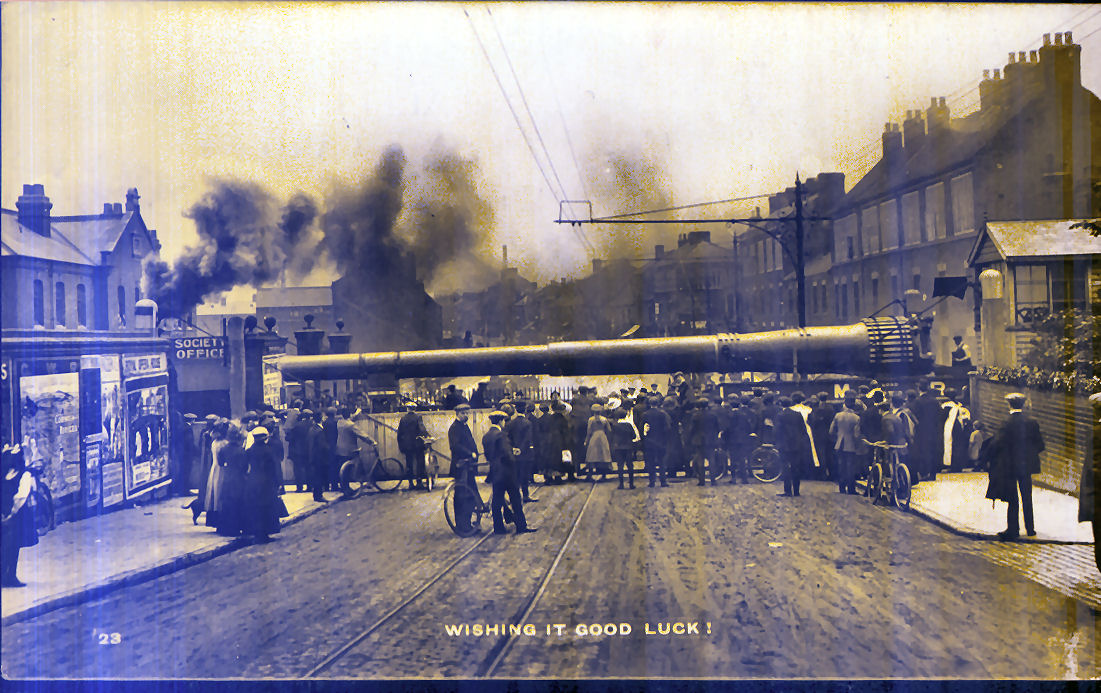
Around 1905 John Brown of Glasgow and Cammel Laird built the Ordnance Works in Red Lane taking over the company of H.H.Mulliner of Birmingham. They built guns for battleships amongst many other weapons. About 40 different post cards were issued with mottoes like that on this card. I wondered why they would issue cards with this information in the middle of a major war. The answer is, I am certain that the Germans knew exactly what was going on there. Secondly the work was heavy and done mainly by skilled men. Such was the trauma of the huge death toll in France that girls were driven to accuse the workers of cowardice by offering them white feathers. The post cards were an attempt to protect the men from their understandable but misplaced anger.
After I told this story a lady told me her father had received a white feather working in the factory of Alfred Herbert. He had been fifteen years old. Both of my grandfathers were skilled toolmakers and were inducted into the army and sent to Coventry. One worked in the Ordnance and the other at Alfred Herbert.

This was the tool room of the Ordnance Works around 1908. I operated a few machines virtually identical to this as late as 1990 alongside modern computer controlled machines.
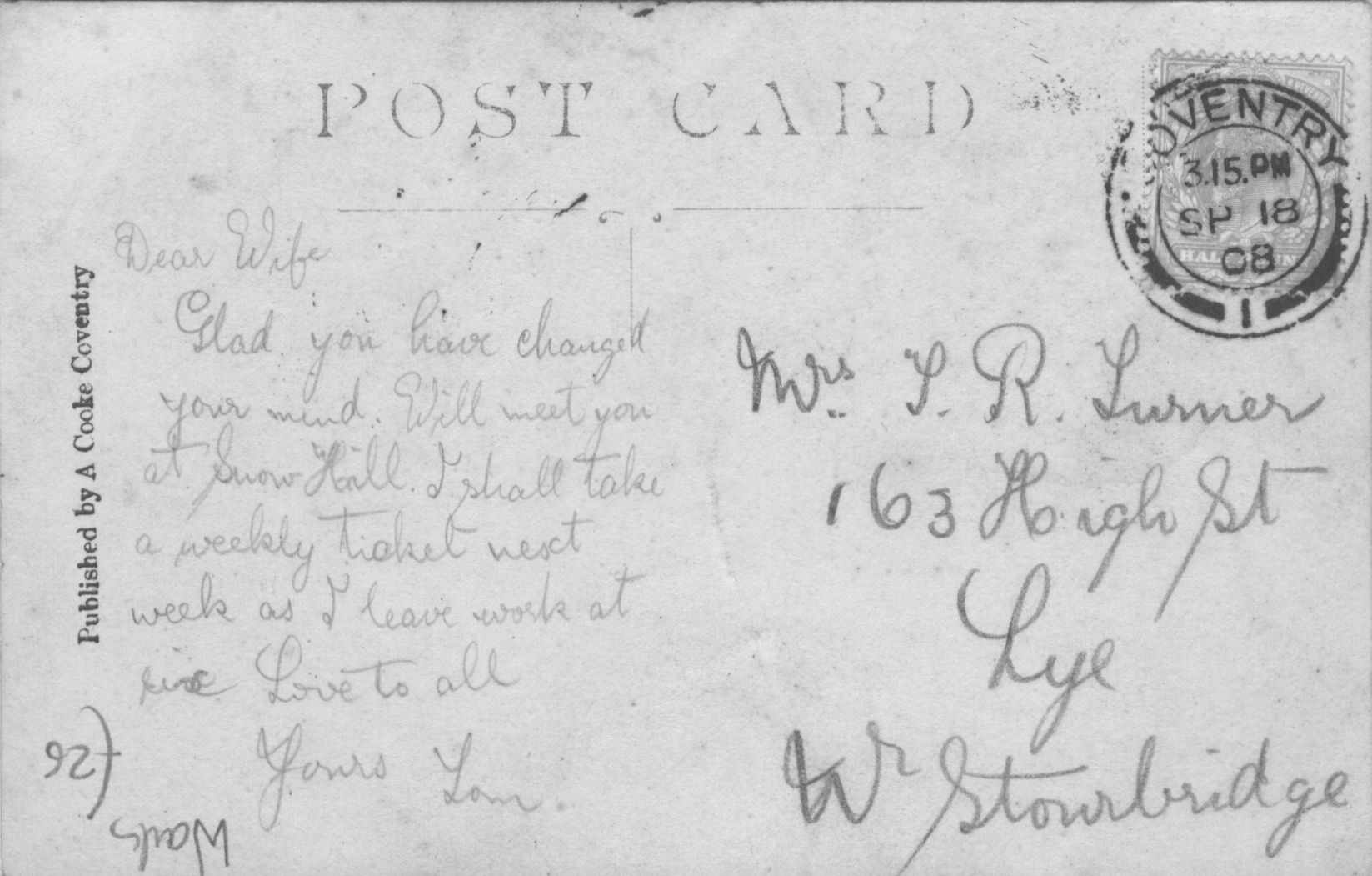
The reverse of this card bears a lovely message written to Mrs.J.R.Turner, 163 High St., Lye, Stourbridge.
Dear Wife,
Glad you have changed your mind. I will meet you at Snow Hill. I shall take a weekly ticket next week and I leave work at six. Love to All
Yours. Tom
I'm guessing they had had a reconciliation. Lord knows how they ever met.
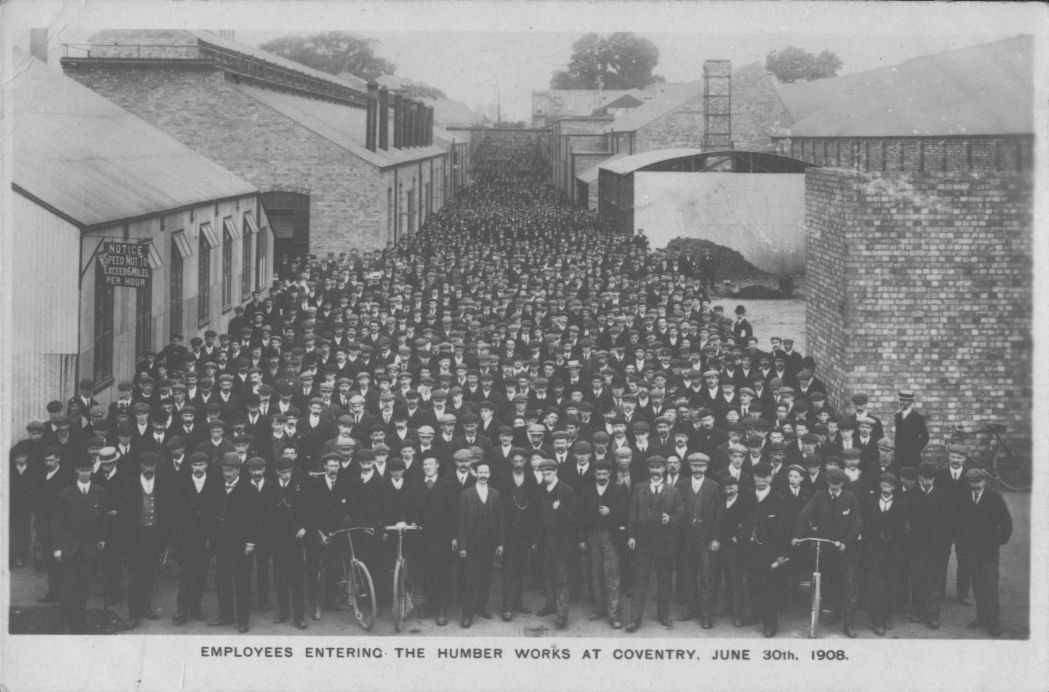
The card says workers entering the Humber Factory but they were, in fact, waiting for the finish hooter. This is - probably - number 3 drive at Humber Road. I worked there in 1973.

The Daimler works occupied this former mill building before building a new factory on the airfield at Radford.
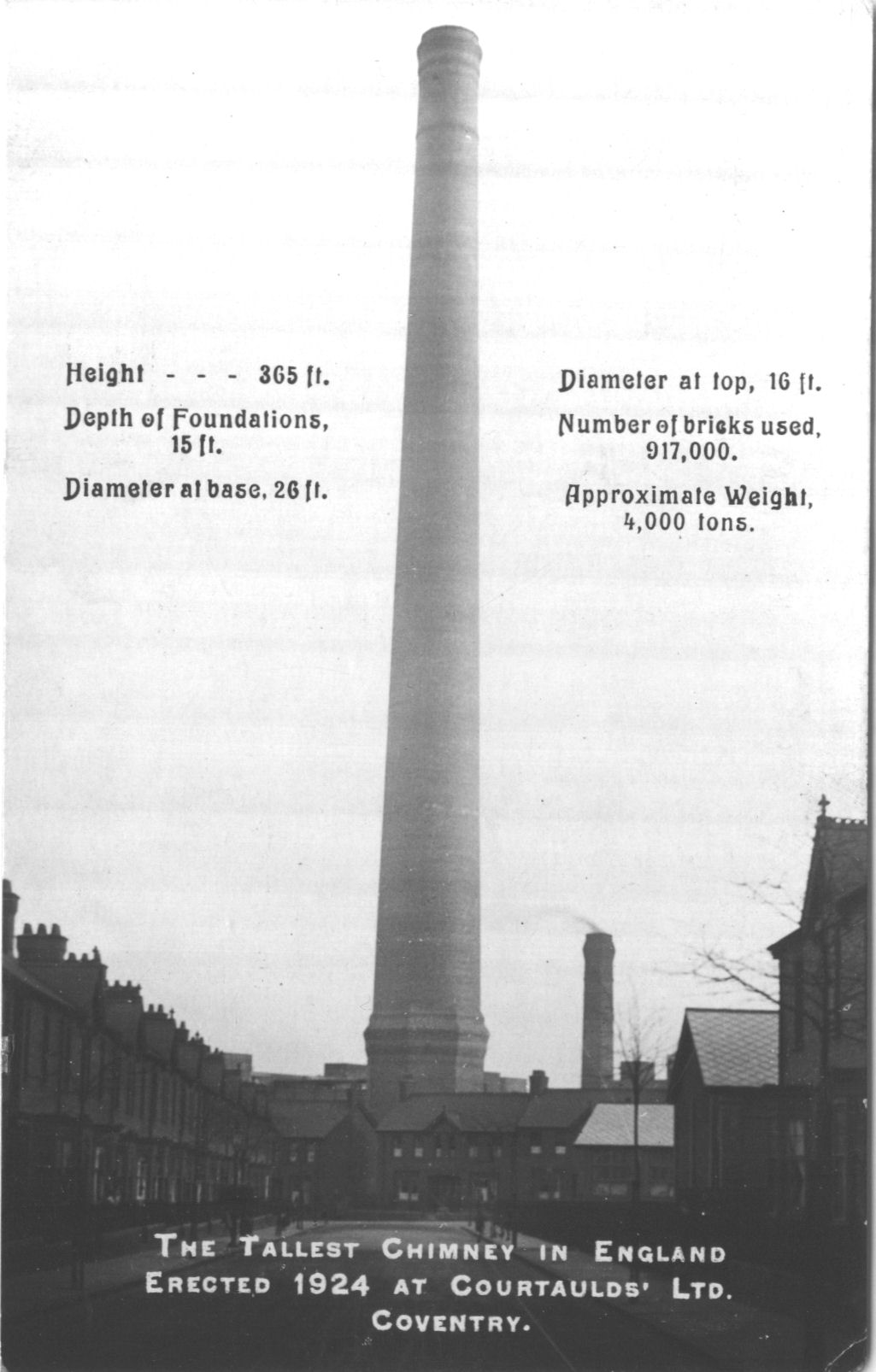
Courtaulds started in Coventry early in the 20th century and became one of the biggest nylon spinners on the planet. Coventry was proud of its industry. Between 1930 and 1940 the government Hot-Housed Coventry by building huge "Shadow Factories" around the city and effectively giving them to booming companies. A lot of political histories say that Britain was not ready for war in 1939. Coventry most certainly was and Hitler was quite correct to target its industrial capacity. He just chose a nasty way to do it and later Bomber Harris and Bomber Command made the German people pay the price.
Alfred Herbert became the biggest machine tool company on earth. Peel Connor Telephone works later became GEC and was a major player in the telephone industry for three quarters of century. Standard Triumph, Humber, Hillman, Rootes, Rover, Riley Armstrong Siddeley, Alvis, Daimler, Massey Ferguson and Jaguar all became household names and Morris made his engines here. Hotchkiss came from France to build Machine Guns and BTH made magnetos and late became Lucas Aerospace. There were literally hundreds of small and medium sized companies servicing these giants.
Armstrong Whitworth built the Whitley bomber and the shadow factory at Baginton built Lancasters. Siddeley Deasy built cars and engines and later became Bristol Siddeley Engines which gave Rolls Royce a run for its money with jet engines for half a century. The only city on earth with a greater concentration of industry was Detroit. Coventry was a boom town from 1920 until 1970 and its population trebled. By 1990 most of its industry had died.